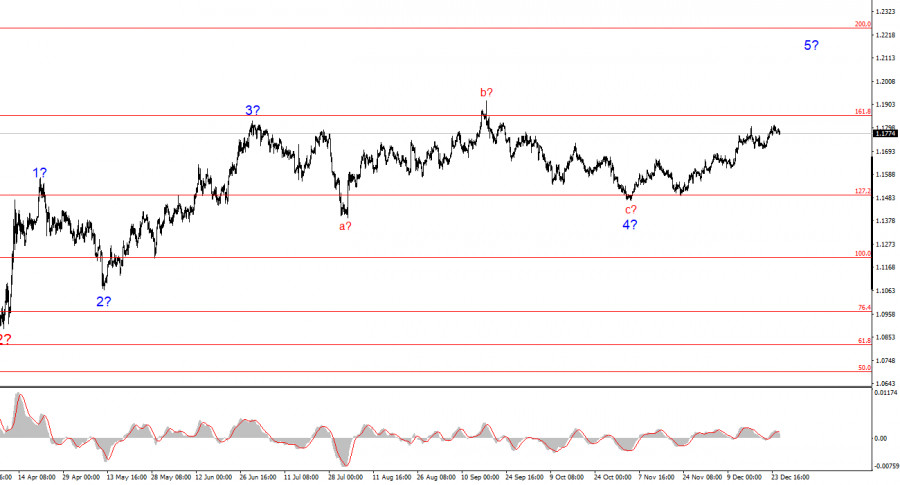Daily Forex market analysis - graphical, wave and technical analysis online
Daily Forex* Trade News, Forex market analysis and Economic News online. In this section you will find a fundamental and technical analysis of the Forex market for trading online and Economic News.
Follow the publications of our experts, and you will be able to objectively assess the situation not only on the international currency market Forex, but on all other world trading platforms. With the help of professional analysis of the foreign exchange market, you can invest your money.
Forex Analytics and Daily FX & Economic News • 29 December 2025

Our daily Forex news of the Currency Market is written by industry veterans with years in trading on market Forex. Read the daily analytics, forecasts, technical and fundamental analysis from experts of the Currency, Cryptocurrency and CFD Market online.
Intraday Strategies for Beginner Traders on December 29
.The euro has slightly declined, while the British pound has maintained its strength. The USD/JPY pair has also somewhat recovered after strong fluctuations.
The lack of reports in the lead-up to the New Year holidays is affecting the situation. Traders, deprived of the usual fuel in the form of economic indicators, are forced to rely on less reliable sources of information, such as market sentiment and speculative forecasts. This leads to increased uncertainty and, consequently, more pronounced fluctuations in currency rates. Many financial institutions and major market players are going on holiday, reducing trading volumes and liquidity. In such conditions, even minor volumes of operations can cause significant price changes.
Today, the only data expected in the first half of the day is the total number of unemployed in France. However, one should not underestimate their potential impact on European markets. In the absence of other important news, even local data can serve as a signal about the overall state of the Eurozone economy, especially given the heightened caution among traders. A surprise in either direction from expected values can lead to short-term but noticeable fluctuations in the euro exchange rate relative to other currencies.
In the afternoon, there will be relative calm in official reports. However, this does not mean the complete absence of market movements. Traders will closely monitor any unofficial comments from central bank representatives and financial regulators.
There are also no reports scheduled for the UK today, so significant movement in the GBP/USD pair is also unlikely.
If the data meets economists' expectations, it is best to operate based on the Mean Reversion strategy. If the data comes in significantly above or below the economists' expectations, the Momentum strategy is preferable.
Momentum Strategy (Breakout):
For the EUR/USD Pair
- Buy on breakout above 1.1781, targeting a rise to 1.1807 and 1.1840.
- Sell on a breakout below 1.1754, targeting a drop to 1.1730 and 1.1706.
For the GBP/USD Pair
- Buy on breakout above 1.3502, targeting a rise to 1.3531 and 1.3561.
- Sell on a breakout below 1.3471, targeting a drop to 1.3442 and 1.3411.
For the USD/JPY Pair
- Buy on breakout above 156.60, targeting a rise to 156.90 and 157.25.
- Sell on a breakout below 156.20, targeting a drop to 155.90 and 155.67.
Mean Reversion Strategy (Retracement):
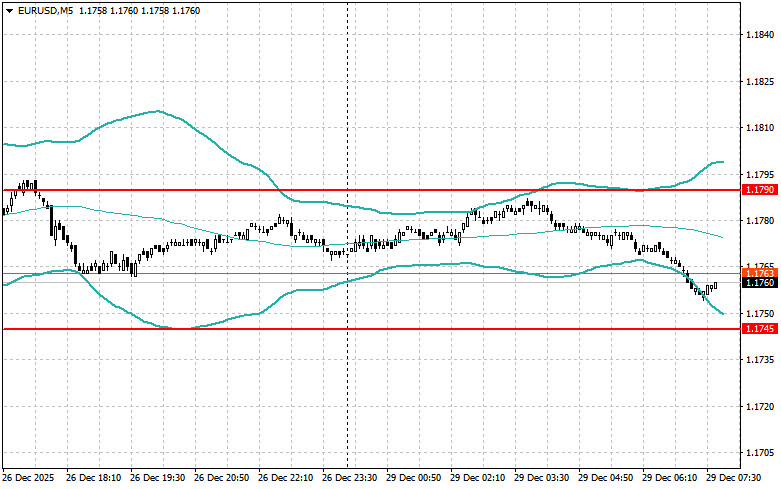
For the EUR/USD Pair
- Look for sell opportunities after a failed breakout above 1.1790 on a return below this level.
- Look for buy opportunities after a failed breakout below 1.1745 on a return to this level.
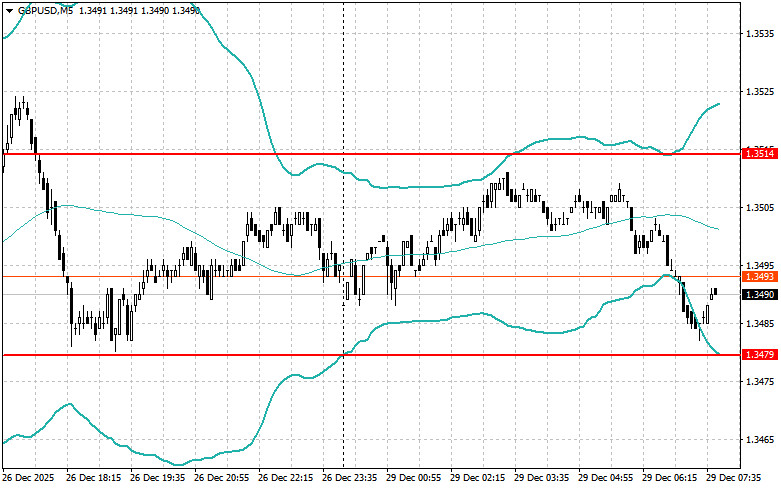
For the GBP/USD Pair
- Look for sell opportunities after a failed breakout above 1.3514 on a return below this level.
- Look for buy opportunities after a failed breakout below 1.3479 on a return to this level.
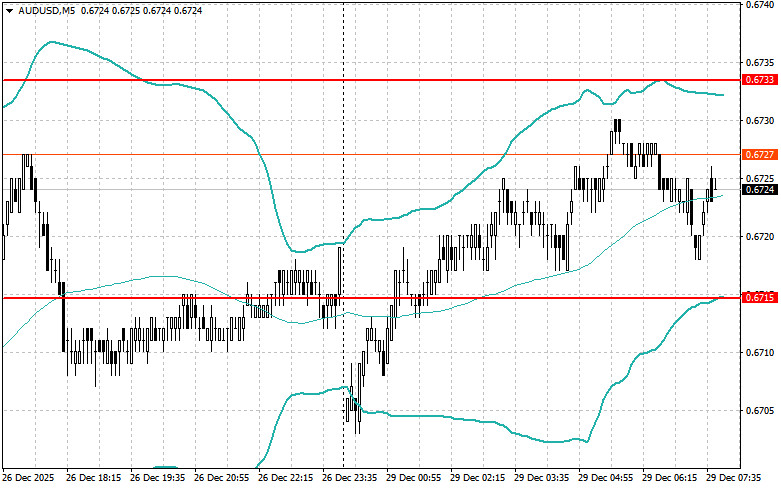
For the AUD/USD Pair
- Look for sell opportunities after a failed breakout above 0.6733 on a return below this level.
- Look for buy opportunities after a failed breakout below 0.6715 on a return to this level.
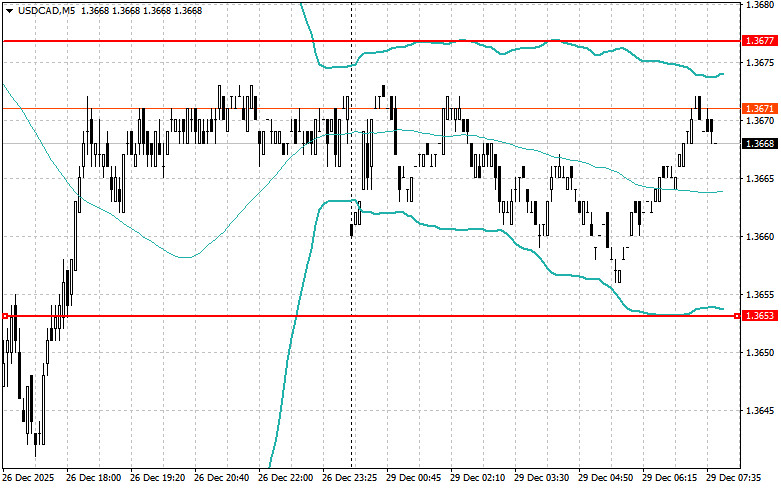
For the USD/CAD Pair
- Look for sell opportunities after a failed breakout above 1.3677 on a return below this level.
- Look for buy opportunities after a failed breakout below 1.3653 on a return to this level.
What to Pay Attention to on December 29? Analysis of Fundamental Events for Beginners
.Review of Macroeconomic Reports:
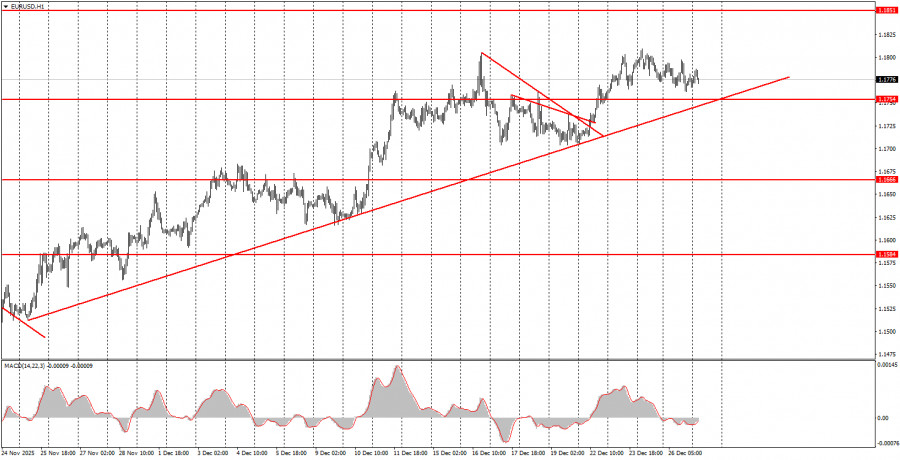
There are no macroeconomic reports scheduled for Monday. The holidays continue. At the beginning of last week, the market moved somewhat, but then it came to a complete standstill. This week, some activity may also be present on Monday and Tuesday, but by Wednesday, there will be a shortened trading day and New Year celebrations, with the market closing on Thursday, and Friday will be the last day of the holiday week. Therefore, we shouldn't expect an abundance of events and movements over the next five days.
Review of Fundamental Events:
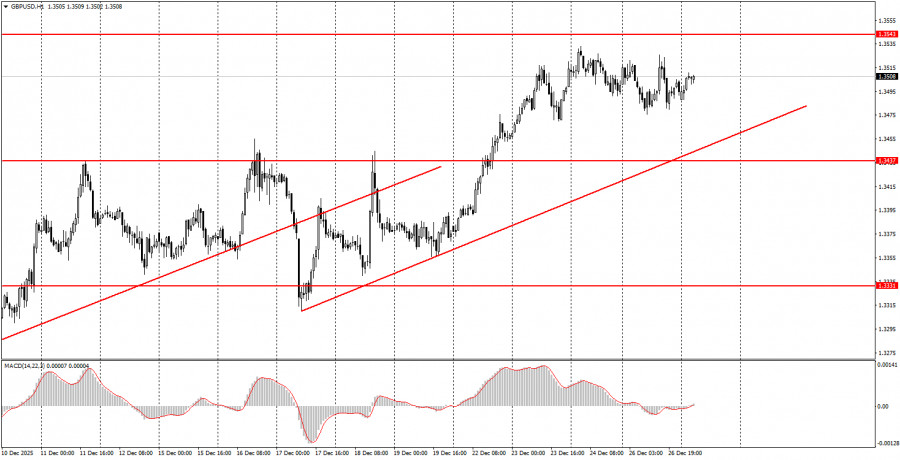
No fundamental events are scheduled for Monday. Governments and central banks have gone on holiday due to Christmas and New Year, so news will start coming in next year. The first interesting events are planned for January 5.
General Conclusions:
During the first trading day of the New Year week, both currency pairs may trade sluggishly. Short-term trends for both currency pairs remain upward, while the market is fully engaged in holiday celebrations. The "thin market" factor may lead to trend movements, but this cannot be predicted. We would expect a low-volatility flat today.
Key Rules of the Trading System:
- The strength of a signal is determined by the time it takes to form the signal (bounce or breakout). The less time it takes, the stronger the signal.
- If two or more trades were opened near a certain level based on false signals, all subsequent signals from that level should be ignored.
- In a flat, any pair can form a multitude of false signals or none at all. At the first signs of a flat, it is better to stop trading.
- Trades are opened during the time between the start of the European session and mid-American session, after which all trades should be closed manually.
- On the hourly timeframe, using signals from the MACD indicator, it is preferable to trade only when good volatility exists, and a trend is confirmed by a trend line or channel.
- If two levels are too close to each other (5 to 20 pips), they should be viewed as an area of support or resistance.
- After moving 15-20 pips in the right direction, a Stop Loss should be set to breakeven.
Chart Explanations:
- Support and Resistance Levels: Levels that serve as targets for opening buys or sells. Take Profit levels can be placed near them.
- Red Lines: Channels or trend lines that reflect the current trend and indicate the preferred direction to trade.
- MACD Indicator (14, 22, 3): A histogram and signal line, a supplementary indicator that can also be used as a source of signals.
Important Note: Significant speeches and reports (always included in the news calendar) can greatly influence the movement of the currency pair. Therefore, during their release, it is advisable to trade cautiously or exit the market to avoid sharp reversals against the preceding movement.
Remember: For beginners trading in the Forex market, it is crucial to understand that not every trade can be profitable. Developing a clear strategy and implementing sound money management are keys to successful long-term trading.
The material has been provided by InstaForex Company - www.instaforex.com.How to Trade the GBP/USD Currency Pair on December 29? Simple Tips and Trade Breakdown for Beginners
.Trade Analysis for Friday:
1-Hour Chart of the GBP/USD Pair
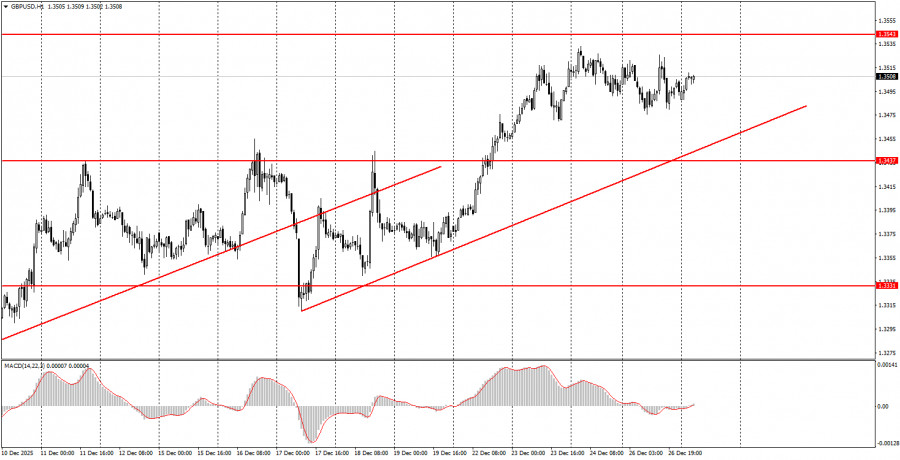
The GBP/USD pair moved similarly to the EUR/USD pair on Friday—there were virtually no movements, and volatility was minimal. This is not surprising, as the macroeconomic backdrop last week was only present on Tuesday, trading ended early on Wednesday, and Thursday was a holiday. We can expect a similar picture this week. The macroeconomic and fundamental backdrop is absent; Wednesday is a shortened trading day; Thursday is a holiday; and on Friday, the market will likely not trade. Therefore, some movements may be observed on Monday and Tuesday, but then it will be back to holiday mode. The upward trend for the British currency persists, so even in the short term, novice traders can expect growth, let alone in the long term. However, we anticipate a resumption of trend movements starting January 5, when macroeconomic information begins to flow in, and the market fully wraps up its Christmas and New Year festivities.
5-Minute Chart of the GBP/USD Pair
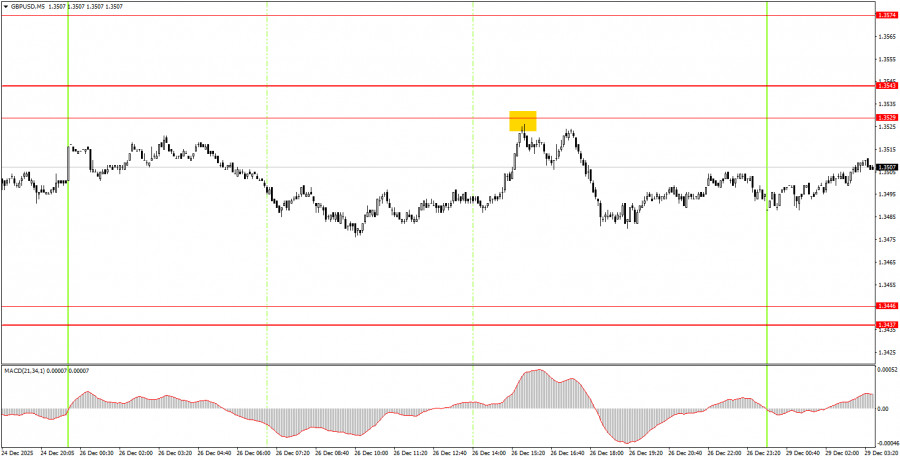
On the 5-minute timeframe, one trading signal for a sell was formed on Friday with a slight margin of error. The price bounced off the 1.3529 level during the U.S. trading session, then moved down by about 30 pips, which novice traders could have captured. Such a profit is a great result for the holiday season.
How to Trade on Monday:
On the hourly timeframe, the GBP/USD pair has completed its flat and has once again started moving upwards. We fully support this scenario, as discussed previously. There are no global grounds for medium-term dollar growth; therefore, we expect movement only to the upside. Overall, we anticipate the resumption of the global upward trend in 2025, which could push the pair to the 1.4000 mark in the next couple of months.
On Monday, novice traders can consider new long positions if the price breaks through the area of 1.3529-1.3543, targeting 1.3574-1.3590. Short positions will become relevant upon a new bounce from the region of 1.3529-1.3543, targeting 1.3437-1.3446.
On the 5-minute timeframe, trading opportunities can currently be identified at the following levels: 1.2913, 1.2980-1.2993, 1.3043, 1.3096-1.3107, 1.3203-1.3212, 1.3259-1.3267, 1.3319-1.3331, 1.3437-1.3446, 1.3529-1.3543, 1.3574-1.3590. On Monday, no significant events are scheduled in the UK or the US, and market volatility may remain weak. The market is currently "thin," making it easier for market makers to move prices than in regular times, but this does not automatically mean they want to do so.
Key Rules of the Trading System:
- The strength of a signal is assessed by the time it takes to form the signal (bounce or breakout). The less time it takes, the stronger the signal.
- If two or more trades were opened near any level based on false signals, all subsequent signals from that level should be ignored.
- In a flat, any pair can create numerous false signals or none at all. In any case, it's better to stop trading at the first signs of a flat.
- Trades are opened during the period between the start of the European session and the middle of the American session, after which all trades must be closed manually.
- On the hourly timeframe, when trading based on signals from the MACD indicator, it is preferable to trade only when good volatility is present, and a trend is confirmed by a trend line or channel.
- If two levels are positioned too closely to each other (5 to 20 points), they should be viewed as a support or resistance area.
- After moving 20 pips in the right direction, set the Stop Loss to breakeven.
Chart Explanation:
- Support and Resistance Levels: Levels that serve as targets for opening buys or sells. Take Profit levels can be placed near them.
- Red Lines: Channels or trend lines that reflect the current trend and indicate the preferred direction for trading.
- MACD Indicator (14, 22, 3): A histogram and signal line, a supplementary indicator that can also be used as a source of signals.
Important Note: Significant speeches and reports (always included in the news calendar) can greatly influence the movement of the currency pair. Therefore, during their release, it is advisable to trade cautiously or exit the market to avoid sharp reversals against the preceding movement.
Remember: For beginners trading in the Forex market, it is important to understand that not every trade can be profitable. Developing a clear strategy and practicing money management are keys to long-term trading success.
The material has been provided by InstaForex Company - www.instaforex.com.How to Trade the EUR/USD Currency Pair on December 29? Simple Tips and Trade Breakdown for Beginners
.Trade Analysis for Friday:
1-Hour Chart of the EUR/USD Pair
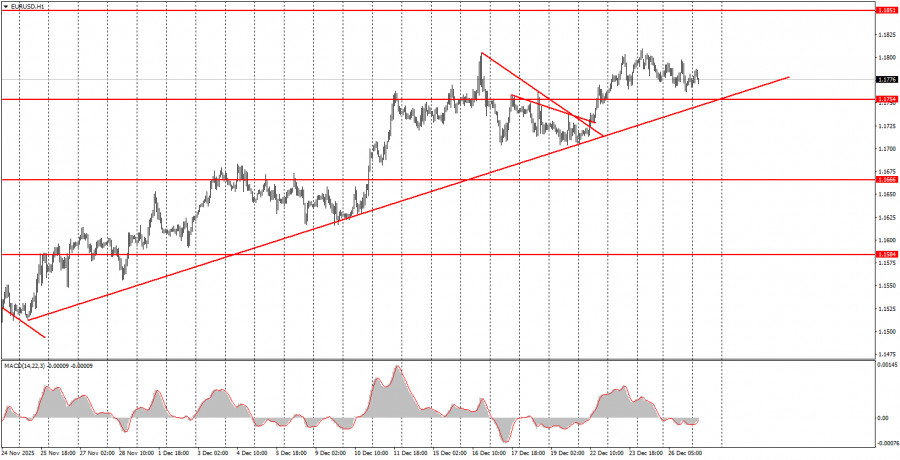
The EUR/USD currency pair showed minimal movement, down 35 pips on Friday. Nothing interesting happened during the day, either in the world, the Eurozone, or the U.S. The market is currently focused on two topics: the holidays and the ceasefire between Ukraine and Russia. However, the first factor significantly reduces the desire to trade, while the second is so tenuous that traders are hesitant to act on it. In any case, we believe there will be no strong movements this week, as the macroeconomic and fundamental backdrop is absent, with New Year's celebrated on Wednesday and Thursday a holiday. Thus, the current week again has a truncated status, with virtually no drivers for movement.
5-Minute Chart of the EUR/USD Pair
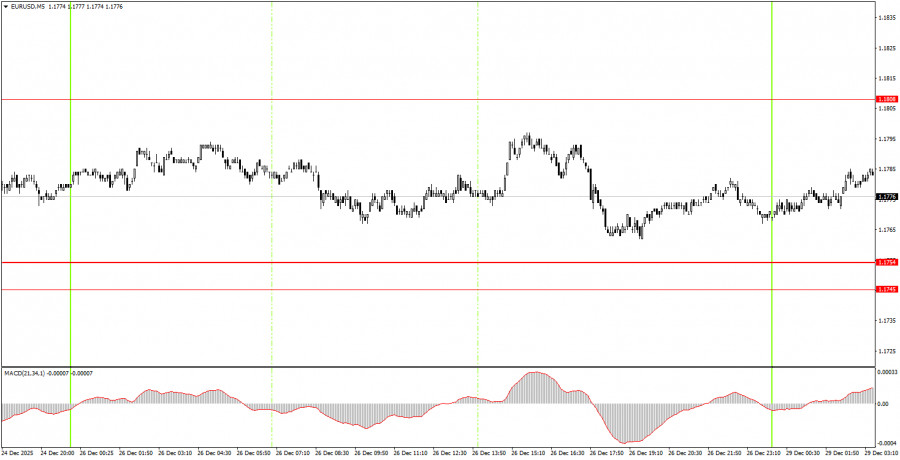
On the 5-minute timeframe, no trading signals were generated on Friday, as the price did not react to any levels or areas during the day. Therefore, novice traders had no grounds to open trades. This could be beneficial, as market volatility is extremely weak due to the holidays.
How to Trade on Monday:
On the hourly timeframe, the EUR/USD pair continues to form an upward trend. The price may soon test the 1.1800-1.1830 area, the upper boundary of the flat on the daily timeframe. It is quite possible that this time we may see a breakout from the six-month sideways channel. The overall fundamental and macroeconomic backdrop remains very weak for the U.S. dollar; we expect growth in the pair in the medium term.
On Monday, novice traders can trade from the area of 1.1745-1.1754. A bounce from this area will make long positions relevant, targeting 1.1808. A break below this area will allow for opening shorts with a target at 1.1666.
On the 5-minute timeframe, the following levels should be considered: 1.1354-1.1363, 1.1413, 1.1455-1.1474, 1.1527-1.1531, 1.1550, 1.1584-1.1591, 1.1655-1.1666, 1.1745-1.1754, 1.1808, 1.1851, 1.1908, and 1.1970-1.1988. On Monday, no significant events or reports are scheduled in either the Eurozone or the U.S. Thus, we can again expect very weak movements today.
Key Rules of the Trading System:
- The strength of a signal is determined by the time it takes to form the signal (bounce or breakout). The less time required, the stronger the signal.
- If two or more trades were opened near any level based on false signals, all subsequent signals from that level should be ignored.
- In a flat, any pair may form numerous false signals or none at all. At the first signs of a flat, it is better to stop trading.
- Trades are opened during the period between the beginning of the European session and the middle of the American session, after which all trades should be closed manually.
- On the hourly timeframe, it is preferred to trade only when there is good volatility and a trend confirmed by the trend line or channel, using signals from the MACD indicator.
- If two levels are too close to each other (5 to 20 pips), they should be viewed as a support or resistance area.
- Upon moving 15 pips in the right direction, set the Stop Loss to breakeven.
Chart Explanations:
- Support and Resistance Levels: Levels that serve as targets for opening buys or sells. Take Profit levels can be placed near them.
- Red Lines: Channels or trend lines that reflect the current trend and indicate the preferred direction for trading.
- MACD Indicator (14, 22, 3): A histogram and signal line; a supplementary indicator that can also be used as a source of signals.
Important Note: Significant speeches and reports (always included in the news calendar) can greatly influence the movement of the currency pair. Therefore, during their release, it is advisable to trade cautiously or exit the market to avoid sharp reversals against the preceding movement.
Remember: For beginners trading in the Forex market, it is important to understand that not every trade can be profitable. Developing a clear strategy and practicing money management are keys to long-term trading success.
The material has been provided by InstaForex Company - www.instaforex.com.GBP/USD Review: Week Preview. The Pound Can Open Champagne Calmly
.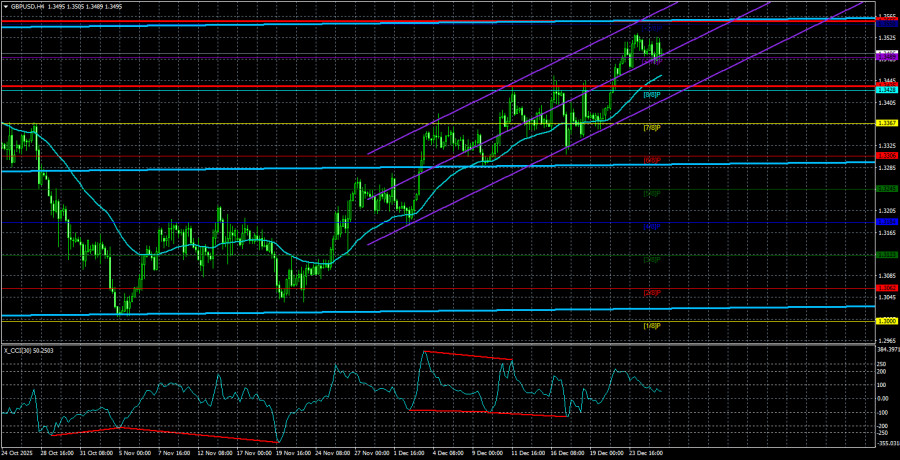
The GBP/USD currency pair showed ultra-weak volatility on Friday, but overall, the British pound is finishing the year in a very good position. Yes, it corrected significantly during the second half of 2025, even more so than the EUR/USD pair. However, in December, the British currency primarily rose and managed to surpass the Ichimoku cloud on the daily timeframe. Thus, the pound has everything it needs to continue its upward trend in 2026.
During the New Year week, both the UK and the U.S. have empty event calendars. In America, reports on jobless claims, manufacturing business activity (not ISM), and Chicago business activity will be released. In the UK, the manufacturing sector's business activity index will be published in its second estimate for December. None of the aforementioned data will attract much interest. December saw a large number of significant and impactful reports published in the U.S. and the UK, so the market now has a nearly complete picture of the state of the American and British economies. Now we need to await new data on key indicators: unemployment, inflation, and the labor market. These data will significantly influence the monetary policies of the Bank of England and the Federal Reserve, which continue to ease policy. We believe that the upward trend of 2025 will continue into 2026.

The average volatility of the GBP/USD pair over the last five trading days is 60 pips, which is considered "medium-low" for the pound-dollar pair. On Monday, December 29, we expect movement within the range limited by the levels of 1.3435 and 1.3555. The upper channel of the linear regression is downward-sloping, but this is solely due to technical corrections on the higher timeframes. The CCI indicator has entered oversold territory 6 times in recent months and has formed numerous "bullish" divergences, constantly signaling a resumption of the upward trend. Last week, the indicator formed another bullish divergence, again signaling a potential return to growth.
Nearest Support Levels:
- S1 – 1.3489
- S2 – 1.3428
- S3 – 1.3367
Nearest Resistance Levels:
- R1 – 1.3550
Trading Recommendations:
The GBP/USD pair is attempting to resume the upward trend of 2025, and its long-term prospects remain unchanged. Donald Trump's policies will continue to exert pressure on the dollar, so we do not expect the American currency to appreciate. Thus, long positions targeting 1.3550 and 1.3555 remain relevant in the near term as long as the price is above the moving average. If the price is below the moving average line, minor shorts can be considered with targets of 1.3367 and 1.3306 on technical grounds. Occasionally, the American currency shows corrections (in a global sense), but for trend strengthening, it needs signs of resolution in the trade war or other global positive factors.
Explanations to Illustrations:
- Linear Regression Channels help determine the current trend. If both are aligned in the same direction, the trend is strong.
- Moving Average Line (settings 20.0, smoothed) indicates the short-term trend and the direction in which trading should be conducted.
- Murray Levels – target levels for movements and corrections.
- Volatility Levels (red lines) indicate the probable price channel in which the pair will stay over the next day, based on current volatility indicators.
- CCI Indicator – its entry into oversold territory (below -250) or overbought territory (above +250) signifies an approaching trend reversal in the opposite direction.
Trading Recommendations and Analysis for EUR/USD on December 29. Euro Maintains Upward Bias
.Analysis of EUR/USD on 5-Minute Chart
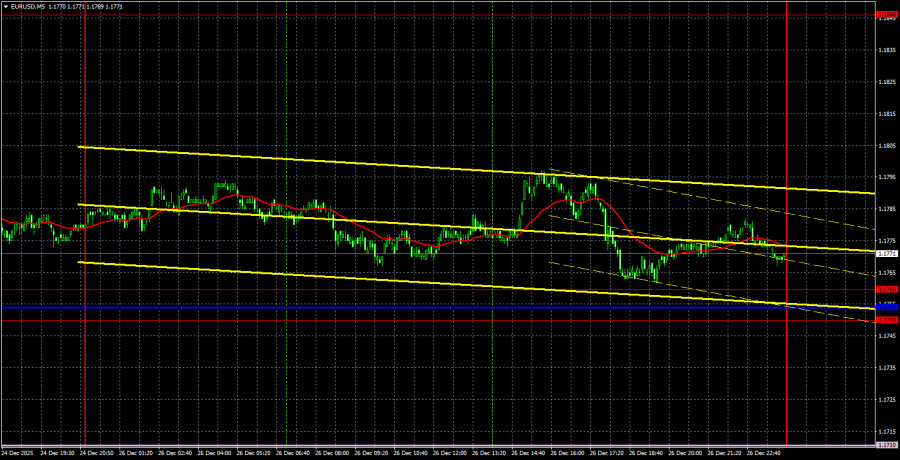
The EUR/USD currency pair traded very weakly on Friday. This is not surprising, as Christmas and New Year celebrations are ongoing worldwide. With more holidays, traders had less motivation to open positions, and there was no macroeconomic or fundamental backdrop. Therefore, strong and trending movements are unlikely until the end of the year. This week, the economic calendar for the Eurozone and the U.S. is empty.
From a technical standpoint, the upward trend remains on the hourly timeframe, as evidenced by the trend line. We consider the primary task for the euro this week to stay above this trend line to continue rising at the start of the new year. The euro is also supported by the Ichimoku indicator lines. A bounce from the area of 1.1750-1.1760 today could provoke a slight rise in the pair.
On the 5-minute chart, no trading signals were formed on Friday, and the price remained predominantly sideways throughout the day. Traders had no grounds to open trading positions.
COT Report
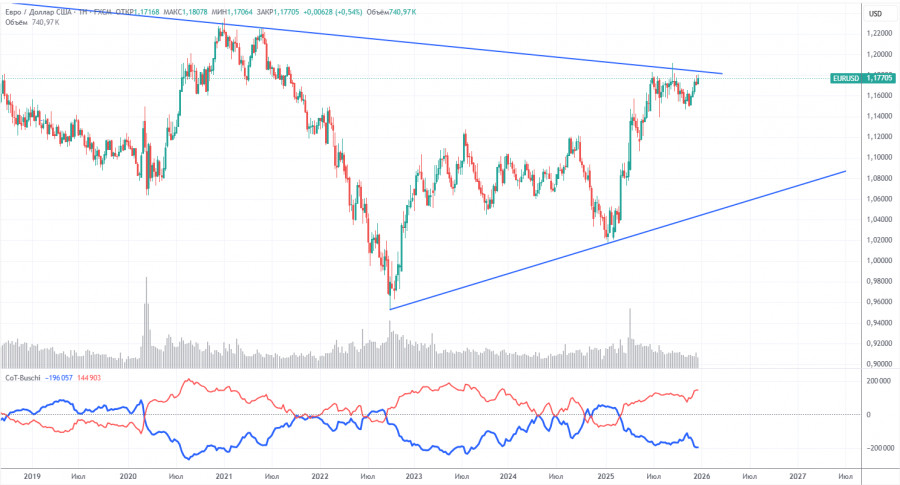
The latest COT report is dated December 16. The illustration above clearly shows that the net position of non-commercial traders has been bullish for a long time, with bears struggling to gain supremacy at the end of 2024, but quickly losing it. Since Trump took office as president of the United States for a second time, only the dollar has been declining. While we cannot say with 100% certainty that the dollar's decline will continue, current global developments suggest this is a possibility. The red and blue lines are moving further apart, indicating a strong advantage for the bulls.
We still do not see any fundamental factors that would strengthen the euro, but there are plenty of factors supporting a decline in the dollar. The global downward trend remains intact, but what does it matter where the price has moved over the last 17 years? For the past three years, only the euro has been appreciating, which is also a trend.
The positioning of the red and blue lines in the indicator continues to signal the preservation and strengthening of the bullish trend. During the last reporting week, the number of long positions in the "Non-commercial" group increased by 8,900, while the number of short positions rose by 2,700. Accordingly, the net position increased by 6,200 contracts over the week.
Analysis of EUR/USD on the 1-Hour Timeframe
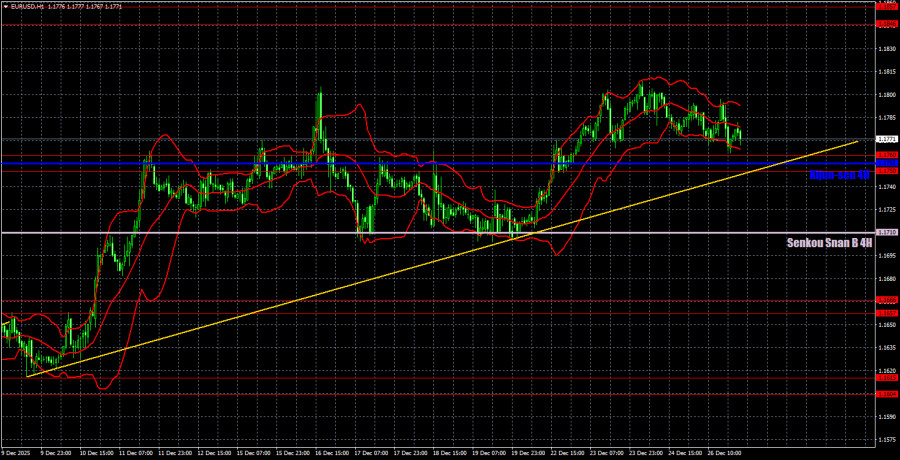
On the hourly timeframe, the EUR/USD pair continues to build a bullish trend. In fact, the upper boundary of the 1.1400-1.1830 range has been tested twice, so we might soon see a technical decline, as the flat persists on the daily timeframe. However, the area of 1.1750-1.1760 is preventing the pair from dropping lower, which means that bulls can make another attempt to break through the upper boundary of the range at any moment.
For December 29, we highlight the following important levels: 1.1234, 1.1274, 1.1362, 1.1426, 1.1542, 1.1604-1.1615, 1.1657-1.1666, 1.1750-1.1760, 1.1846-1.1857, 1.1922, 1.1971-1.1988, as well as the Senkou Span B line (1.1710) and Kijun-sen (1.1755). The Ichimoku indicator lines may shift during the day, which should be taken into account when determining trading signals. Don't forget to set a Stop Loss at breakeven if the price moves in the correct direction by 15 pips. This will protect against possible losses if the signal turns out to be false.
On Monday, no significant events or reports are scheduled in the Eurozone or the U.S. Movement may be weak during the day and trendless.
Trading Recommendations:
On Monday, traders may trade in the 1.1750-1.1760 range. A price bounce from this area will make long positions relevant, with a target in the 1.1800-1.1830 range. A break below this area will lead to a decline toward the Senkou Span B line.
Explanations to Illustrations:
- Support and Resistance Levels – Thick red lines, around which movement may end. They are not sources of trading signals.
- Kijun-sen and Senkou Span B Lines – Lines from the Ichimoku indicator, projected onto the hourly timeframe from a 4-hour timeframe. They are strong lines.
- Extreme Levels – Thin red lines from which the price previously bounced. They are sources of trading signals.
- Yellow Lines – Trend lines, trend channels, and any other technical patterns.
- Indicator 1 on COT Charts – Size of the net position of each category of traders.
EUR/USD Review: Week Preview. Holidays Continue
.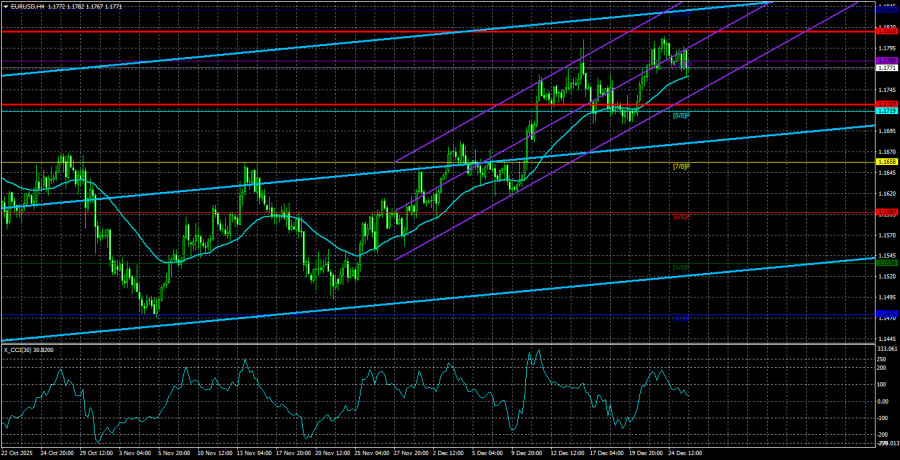
The EUR/USD currency pair did not show any interesting movements on Friday, and volatility during the holidays has dropped nearly to zero. However, we can forget about last week and shift our attention to the upcoming week, which also has a "holiday" status. One can immediately assume that the New Year week will likely follow a similar pattern to Christmas week. In the first 2-3 weeks, some market movements may occur, but Thursday is a holiday, and it is unlikely that anyone will want to trade on Friday right before and after the holidays. The economic calendar for both the Eurozone and the U.S. is empty.
Thus, throughout the week, trading (or not trading) will largely depend on technical factors. The only reports in the Eurozone will be published on Friday—the business activity indices for the services and manufacturing sectors for December. These data could have influenced market sentiment if they were at least the first estimates. However, they will be second estimates and therefore attract little interest. There are no other significant events planned.
As a result, volatility this week is likely to be weak. Even if the "thin market" concept works, predicting movements can only be done based on technical factors. It is important to remember that a key point for the EUR/USD pair remains the flat on the daily timeframe, and in our opinion, the likelihood of its ending during the New Year week is extremely low. However, anything is possible in the currency market. We previously stated that the market is driven by market makers, whose goal is to provide liquidity to other traders. Therefore, to succeed, market makers need to outmaneuver other market participants. If it is necessary to move the pair up or down during the New Year, that is entirely possible.
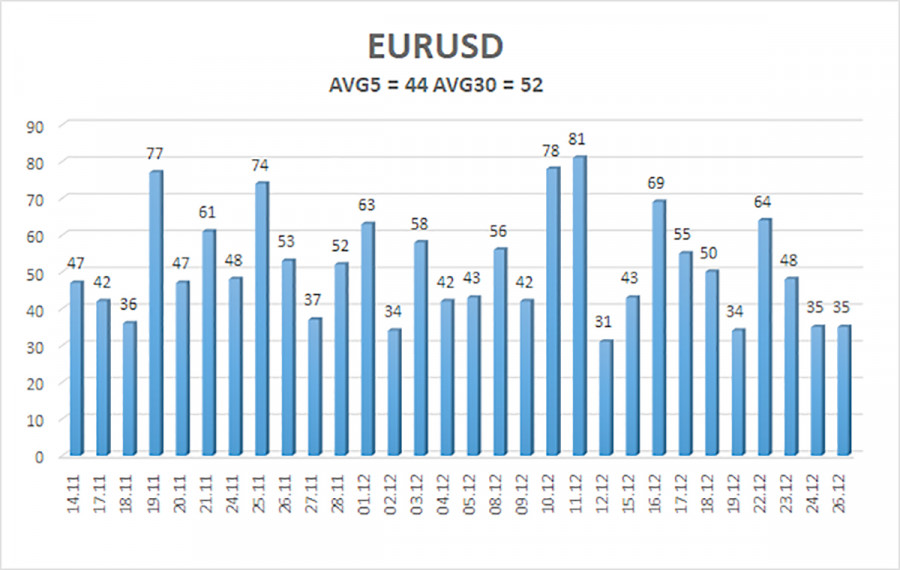
The average volatility of the EUR/USD pair over the last five trading days, as of December 29, is 44 pips and is classified as "low." We expect the pair to trade between 1.1727 and 1.1815 on Monday. The upper channel of the linear regression is turning upwards, but the flat continues on the daily timeframe. The CCI indicator entered oversold territory twice in October but moved to overbought territory at the beginning of December. We have already seen a small retracement.
Nearest Support Levels:
- S1 – 1.1719
- S2 – 1.1658
- S3 – 1.1597
Nearest Resistance Levels:
- R1 – 1.1780
- R2 – 1.1841
Trading Recommendations:
The EUR/USD pair is positioned above the moving average line, and the upward trend remains intact across all higher timeframes, while the flat continues for the sixth month on the daily timeframe. The global fundamental backdrop remains significantly negative for the dollar. Over the past six months, the dollar has shown weak growth at times, but exclusively within the sideways channel. It lacks a fundamental basis for long-term strengthening. If the price is below the moving average, small shorts can be considered, targeting 1.1727 on purely technical grounds. Long positions remain relevant above the moving average line, targeting 1.1829 and 1.1830 (the upper boundary of the flat on the daily timeframe), which have already been effectively targeted. Now we need the flat to conclude.
Explanations to Illustrations:
- Linear Regression Channels help determine the current trend. If both are aligned in the same direction, the trend is strong.
- Moving Average Line (settings 20.0, smoothed) indicates the short-term trend and the direction in which trading should be conducted.
- Murray Levels – target levels for movements and corrections.
- Volatility Levels (red lines) indicate the probable price channel in which the pair will stay over the next day, based on current volatility indicators.
- CCI Indicator – its entry into oversold territory (below -250) or overbought territory (above +250) signifies an approaching trend reversal in the opposite direction.
Trading Recommendations and Analysis for GBP/USD on December 29. Pound on Holiday
.Analysis of GBP/USD on 5-Minute Chart
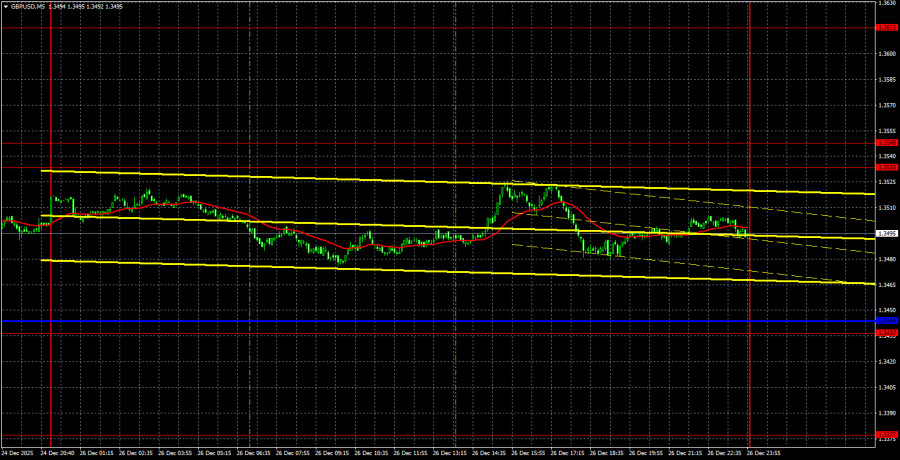
The GBP/USD pair traded with minimal volatility on Friday. This is not surprising, as Christmas and New Year celebrations are ongoing worldwide. With more holidays, traders had less motivation to open positions, and there was no macroeconomic or fundamental backdrop. Thus, trading activity will likely shift to next week. Technical analysis remained unchanged, and there were no news events to analyze.
On the hourly timeframe, a new ascending trend is still evident, with a new trend line forming. Discussing the pound's prospects for this week seems unnecessary. The economic calendar is empty, and the pair's medium-term outlook is clear. Of course, this does not mean that downward corrections are impossible or that the British currency will appreciate throughout January. However, we have analyzed the overall fundamental picture numerous times. Therefore, we expect only declines from the U.S. dollar in 2026.
On the 5-minute timeframe, no trading signals were formed on Friday. The price was unable to hold either the critical line or the 1.3533-1.3548 range throughout the day. Overall volatility for the day was 50 pips.
COT Report

COT reports for the British pound indicate that commercial traders' sentiment has been changing consistently in recent years. The red and blue lines, which represent the net positions of commercial and non-commercial traders, frequently intersect and, in most cases, remain close to the zero mark. Currently, the lines are moving apart, but non-commercial traders dominate with short positions. Speculators are increasingly selling the pound, but, as we have mentioned, it does not matter how low the demand for the British currency is. The demand for the U.S. dollar is often even lower.
The dollar continues to decline due to Donald Trump's policies, as seen on the weekly timeframe (illustration above). The trade war will continue in one form or another for a long time. The Federal Reserve will, in any case, lower the rate in the next 12 months. Demand for the dollar will decrease one way or another. According to the latest COT report (dated December 16) for the British pound, the "Non-commercial" group opened 1,600 buy contracts and closed 25,400 sell contracts. Thus, the net position of non-commercial traders increased by 27,000 contracts over the week.
In 2025, the pound rose significantly, but it should be understood that there is only one reason: Trump's policies. Once this reason is neutralized, the dollar may start to appreciate, but when that will happen is anyone's guess.
Analysis of GBP/USD on the 1-Hour Timeframe

On the hourly timeframe, the GBP/USD pair continues to form a new upward trend, but the market is currently on a holiday pause. We believe that the British pound's growth in the medium-term perspective will continue regardless of the local macroeconomic and fundamental backdrop. The trend for the pound remains upward across almost all timeframes.
For December 29, we highlight the following important levels: 1.2863, 1.2981-1.2987, 1.3042-1.3050, 1.3096-1.3115, 1.3201-1.3212, 1.3307, 1.3369-1.3377, 1.3437, 1.3533-1.3548, and 1.3584. The Senkou Span B line (1.3369) and Kijun-sen (1.3444) may also serve as sources of signals. It is recommended to set the Stop Loss to breakeven upon a price movement of 20 pips in the correct direction. The lines of the Ichimoku indicator may shift during the day, which should be taken into account when determining trading signals.
On Monday, no significant events or reports are scheduled in the UK or the U.S. The upward movement may continue, but new buy signals are needed; however, flat movement and low volatility are more likely.
Trading Recommendations:
Today, traders may consider selling if the price bounces from the 1.3533-1.3548 area, targeting 1.3444. Long positions will become relevant upon the price stabilizing above the area of 1.3533-1.3548, targeting 1.3615, or upon a bounce from the critical line.
Explanations to Illustrations:
- Support and Resistance Levels – Thick red lines, around which movement may end. They are not sources of trading signals.
- Kijun-sen and Senkou Span B Lines – Lines from the Ichimoku indicator, projected onto the hourly timeframe from a 4-hour timeframe. They are strong lines.
- Extreme Levels – Thin red lines from which the price previously bounced. They are sources of trading signals.
- Yellow Lines – Trend lines, trend channels, and any other technical patterns.
- Indicator 1 on COT Charts – Size of the net position of each category of traders.
EUR/USD: Week Preview. Pre-New Year Vibe, FOMC Minutes, and Unemployment Claims
.The upcoming week, which falls at the turn of the year, lacks important fundamental events. Nevertheless, in a "thin" market, even minor releases can trigger strong volatility. Therefore, every report and every release matter during the New Year period.
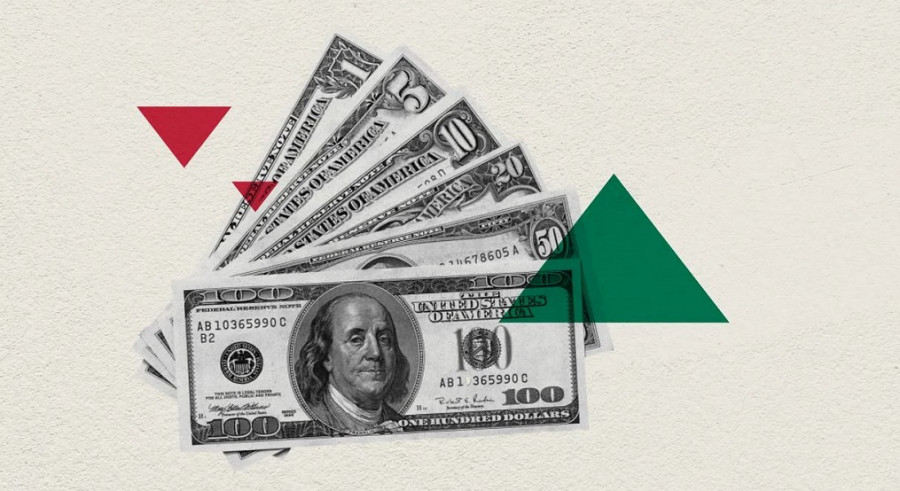
On Monday, data on pending home sales in the U.S. will be released. This report reflects the number of real estate transactions for which contracts have already been signed but not yet closed. It serves as a leading indicator of the American real estate market, as contracts are typically signed well in advance (usually 4-5 weeks) of the actual sale, which correlates with future housing sales data.
According to forecasts, pending home sales for November are expected to increase by only 0.9%, following an almost two percent (1.9%) increase in the previous month. The dollar will come under pressure only if the number unexpectedly falls into negative territory.
On Tuesday, December 30, the FOMC minutes—the protocol of the December Federal Reserve meeting—will be released. Recall that following this meeting, the central bank lowered the interest rate by 25 basis points, implementing the most anticipated scenario. However, the details of the December meeting were quite contradictory.
On one hand, the Federal Reserve did not explicitly announce further rate cuts at one of the upcoming meetings. The updated median forecast (dot plot) suggests only one 25-basis point rate cut in 2026. A similar forecast was communicated following the September meeting as well.
On the other hand, the rhetoric of Fed Chair Jerome Powell during the final press conference was relatively dovish—softer than expected. He emphasized the state of the U.S. labor market, acknowledging that it continues to cool. Powell also mentioned "significant downside risks" for employment. Regarding inflation, he did not dramatize the situation. He stated that inflation has slowed, although it remains "somewhat elevated" relative to the Fed's long-term target of 2%. Meanwhile, short-term inflation expectations have declined (compared to peak values earlier this year).
Overall, market participants interpreted the December meeting results as unfavorable for the dollar. The protocol from this meeting could either amplify or weaken the pressure on the greenback. If the minutes highlight concerns about rising inflation, dovish expectations will dissipate (including in the context of the March meeting), strengthening the dollar's position across markets. Conversely, if the Fed focuses on issues in the U.S. labor market (rising unemployment, slowing hiring, deteriorating supply-demand balance), the dollar will face additional pressure.
It is also important to note that the probability of a rate cut at the January meeting is only 17% (according to the CME FedWatch tool), while the likelihood of a rate cut in March is estimated at 52%. If the tone of the December meeting's minutes is dovish, the chances of a March rate cut could approach 60%, putting pressure on the dollar.
Additionally, on Tuesday, the housing price index for the 20 largest U.S. metropolitan areas, calculated by S&P/Case-Shiller, will be published. This is one of the key indicators of the real estate market's state, widely used for trend analysis. Since January of this year, the index has been showing a downward trend, dropping from 4.8% (January 2025) to 1.4% (September). According to preliminary forecasts, the index is anticipated to decline again in October, this time to 1.1%. For dollar bulls, this indicator must not fall into negative territory (especially if Pending Home Sales, released on Monday, also comes in below zero).
The most significant report on Wednesday will be the Unemployment Claims report. The increase in initial jobless claims has decreased for the second consecutive week, after a sharp spike to 237,000. This week, the indicator may again demonstrate a downward trend, decreasing to 213,000. If the figure aligns with expectations, market reaction will be weak—traders may even ignore the release altogether. Strong volatility is expected only if Unemployment Claims deviates significantly from the projected value—if it is above 220,000 or below 210,000.
On Wednesday, China will also release the manufacturing PMI index. According to forecasts, the indicator will remain in the contraction zone, although it will rise from 49.2 to 49.4. The non-manufacturing activity index is also expected to stay below the 50-point level (49.8). If both indicators exceed the 50.0 mark contrary to forecasts, risk appetite in the market will increase, leading buyers of EUR/USD to strengthen their positions.
Thursday is New Year's Day, so major trading venues worldwide will be closed. The currency market will be paused.
The economic calendar for Friday is also nearly empty. The only report of academic interest is the PMI indices (final data for December), which will be released in key Eurozone countries. However, if the final estimates align with the initial ones (which is most likely), traders will likely ignore this release.
Thus, the upcoming week does not promise to be informative—the most important macroeconomic reports will begin to come out starting January 5. However, amidst a "thin market," even secondary releases can provoke volatility. Attention will be on the FOMC minutes, Unemployment Claims, and U.S. housing market data.
The material has been provided by InstaForex Company - www.instaforex.com.American Dollar: Preview of the Week
.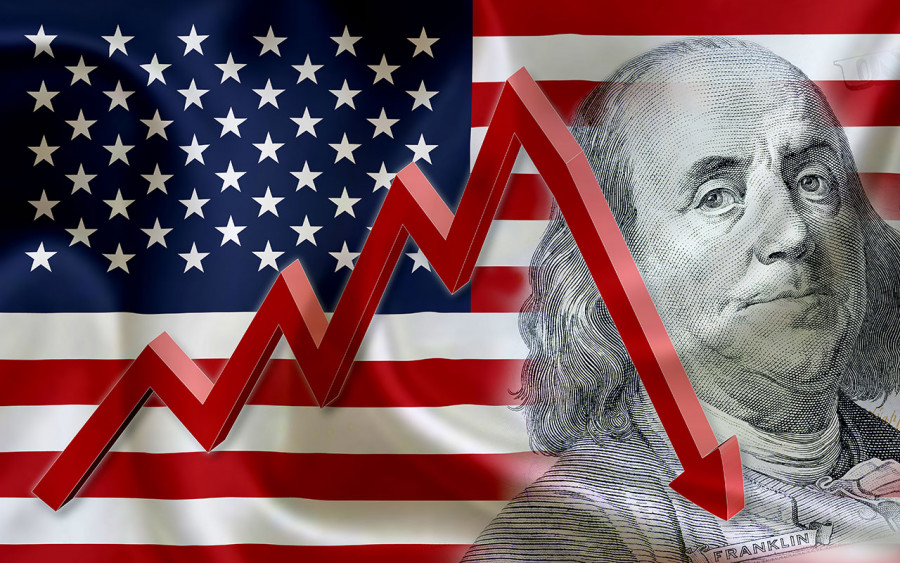
The U.S. dollar will not save EUR/USD or GBP/USD. The U.S. will also be celebrating the New Year; the market will be closed on Thursday, there will be a shortened trading day on Wednesday, and only a few will be willing to open trades on Friday. Among the economic reports, there are the not particularly significant initial and continuing jobless claims report, the somewhat irrelevant Chicago Business Activity Index, and the purely formal FOMC meeting minutes.
Some analysts believe the FOMC minutes, known as the "minutes of the FOMC," are significant to market participants, but I remind you that they are released three weeks after the meeting. In the context of the December FOMC meeting, they hold no value because, right after the meeting, various reports on unemployment, the labor market, and inflation were released, which will determine the Federal Reserve's future decisions on monetary policy. Therefore, even without important economic data, the information about the FOMC meeting loses its relevance almost entirely after three weeks. Given the published data, this protocol has no significance whatsoever. The dollar will not be able to take control of the situation next week as it has done for much of the outgoing year.
Wave Structure of EUR/USD:
Based on the conducted analysis of EUR/USD, I conclude that the instrument continues to build the bullish segment of the trend. Donald Trump's policies and the Fed's monetary policy remain significant factors in the long-term decline of the American currency. The targets of the current trend segment may extend up to the 25th figure. The current upward wave pattern is developing, and we hope we are now witnessing the formation of an impulse wave set that is part of global wave 5. In this case, we should expect growth towards targets around 1.1825 and 1.1926, corresponding to 200.0% and 261.8% on the Fibonacci retracement.
Wave Structure of GBP/USD:
The wave structure of the GBP/USD instrument has changed. The downward corrective structure a-b-c-d-e in C of 4 appears to be complete, as does the entire wave 4. If this is indeed the case, I expect the primary trend segment to resume its development, with initial targets around the 38 and 40 levels.
In the short term, I anticipated the formation of wave 3 or c, with targets around 1.3280 and 1.3360, corresponding to 76.4% and 61.8% of the Fibonacci retracement. These targets have been reached. Wave 3 or c continues its formation, and currently, a fourth attempt to break the 1.3450 mark (equivalent to 61.8% on the Fibonacci retracement) is underway. Movement targets are 1.3550 and 1.3720.
Core Principles of My Analysis:
- Wave structures should be simple and understandable. Complex structures are difficult to trade and often require adjustments.
- If there is uncertainty about what is happening in the market, it is better not to enter it.
- There is never 100% certainty in the direction of movement, and there never can be. Don't forget about protective stop-loss orders.
- Wave analysis can be combined with other forms of analysis and trading strategies.
British Pound: Preview of the Week
.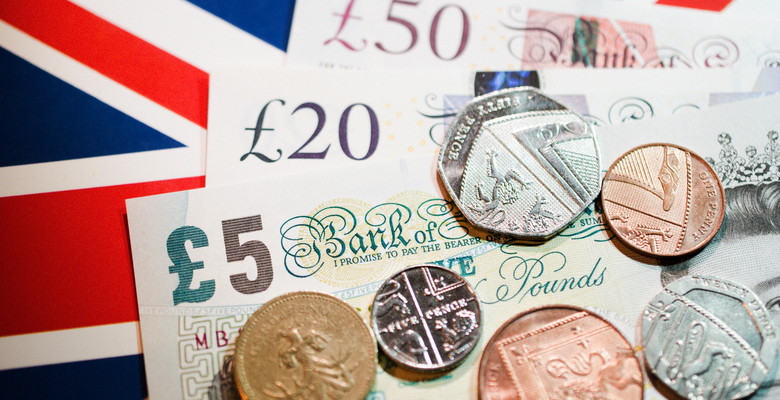
The situation for the British pound is identical to that of the euro. Next week in the UK, only one report will be released—the final assessment of the manufacturing sector's business activity index for December, scheduled for Friday. It is difficult for me to gauge how important this index will be for market participants on January 2, considering that the market will be closed on January 1 and will close again for the weekend on January 3. In my opinion, this report may go unnoticed. No other events are expected in the UK.
One might hope for developments from America and the dollar, but they also enjoy celebrating the New Year and taking holidays. Therefore, wave analysis is the only type of analysis that can offer some guidance on what to expect. However, it is essential to note that we should not expect much in any case. Given that next week is holiday-filled, market activity will be minimal, and the amplitude of movements will be even lower. Thus, it is not particularly important where or by how much the instrument will move over the next four trading days. It is better to focus immediately on January 5, when the market resumes operations, participants will have "recovered" from the holidays, and economic data will start to emerge in the Eurozone, the UK, and the US.
Wave Structure of EUR/USD:
Based on the conducted analysis of EUR/USD, I conclude that the instrument continues to build the bullish segment of the trend. Donald Trump's policies and the Fed's monetary policy remain significant factors in the long-term decline of the American currency. The targets of the current trend segment may extend up to the 25th figure. The current upward wave pattern is developing, and we hope we are now witnessing the formation of an impulse wave set that is part of global wave 5. In this case, we should expect growth towards targets around 1.1825 and 1.1926, corresponding to 200.0% and 261.8% on the Fibonacci retracement.
Wave Structure of GBP/USD:
The wave structure of the GBP/USD instrument has changed. The downward corrective structure a-b-c-d-e in C of 4 appears to be complete, as does the entire wave 4. If this is indeed the case, I expect the primary trend segment to resume its development, with initial targets around the 38 and 40 levels.
In the short term, I anticipated the formation of wave 3 or c, with targets around 1.3280 and 1.3360, corresponding to 76.4% and 61.8% of the Fibonacci retracement. These targets have been reached. Wave 3 or c continues its formation, and currently, a fourth attempt to break the 1.3450 mark (equivalent to 61.8% on the Fibonacci retracement) is underway. Movement targets are 1.3550 and 1.3720.
Core Principles of My Analysis:
- Wave structures should be simple and understandable. Complex structures are difficult to trade and often require adjustments.
- If there is uncertainty about what is happening in the market, it is better not to enter it.
- There is never 100% certainty in the direction of movement, and there never can be. Don't forget about protective stop-loss orders.
- Wave analysis can be combined with other forms of analysis and trading strategies.
Euro Currency: Preview of the Week
.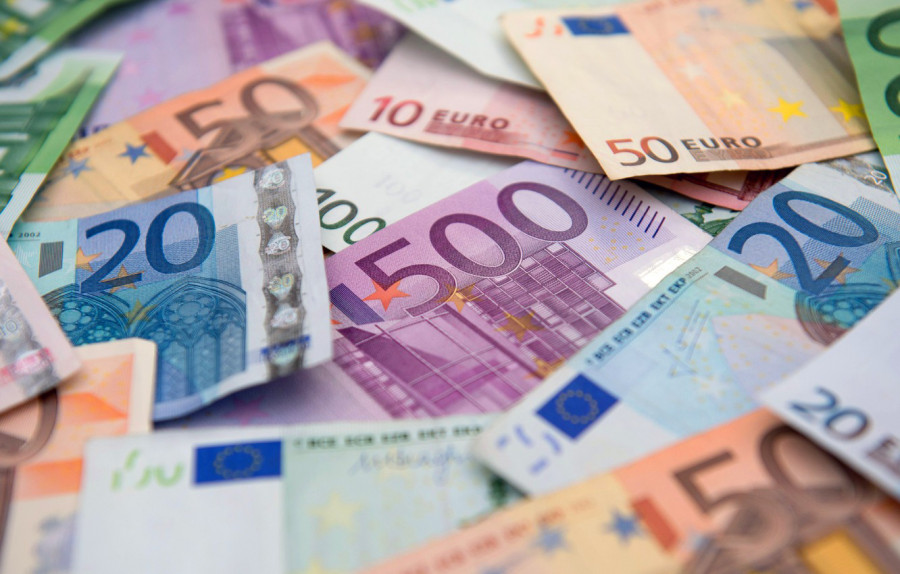
If the upcoming week were not a holiday, I would call it the most boring of the year. Since the market has just celebrated Christmas and the New Year is next week, a news lull should come as no surprise. In the Eurozone and Germany, only the business activity indices for the manufacturing sectors will be released on Friday. However, I doubt anyone in the market will act on the final assessments of business activity for December after Thursday's holiday. Therefore, it can be considered that there will be no news next week.
In the absence of news, we can only rely on wave analysis or Fibonacci levels. I remind you that we saw a three-wave upward structure, with the third wave taking a clear five-wave form. Consequently, in the next week or two, a corrective wave four may be forming, or a new set of downward waves may begin. In the latter case, global wave four could take on an even more complex and extended form. Frankly, I wouldn't want that, as in this scenario, the sideways movement could last for another couple of months. However, the market is unlikely to be concerned with what other traders or I want.
Wave Structure of EUR/USD:
Based on the conducted analysis of EUR/USD, I conclude that the instrument continues to build the bullish segment of the trend. Donald Trump's policies and the Fed's monetary policy remain significant factors in the long-term decline of the American currency. The targets of the current trend segment may extend up to the 25th figure. The current upward wave pattern is developing, and we hope we are now witnessing the formation of an impulse wave set that is part of global wave 5. In this case, we should expect growth towards targets around 1.1825 and 1.1926, corresponding to 200.0% and 261.8% on the Fibonacci retracement.
Wave Structure of GBP/USD:
The wave structure of the GBP/USD instrument has changed. The downward corrective structure a-b-c-d-e in C of 4 appears to be complete, as does the entire wave 4. If this is indeed the case, I expect the primary trend segment to resume its development, with initial targets around the 38 and 40 levels.
In the short term, I anticipated the formation of wave 3 or c, with targets around 1.3280 and 1.3360, corresponding to 76.4% and 61.8% of the Fibonacci retracement. These targets have been reached. Wave 3 or c continues its formation, and currently, a fourth attempt to break the 1.3450 mark (equivalent to 61.8% on the Fibonacci retracement) is underway. Movement targets are 1.3550 and 1.3720.
Core Principles of My Analysis:
- Wave structures should be simple and understandable. Complex structures are difficult to trade and often require adjustments.
- If there is uncertainty about what is happening in the market, it is better not to enter it.
- There is never 100% certainty in the direction of movement, and there never can be. Don't forget about protective stop-loss orders.
- Wave analysis can be combined with other forms of analysis and trading strategies.
What Drives the Growth of the American Economy?
.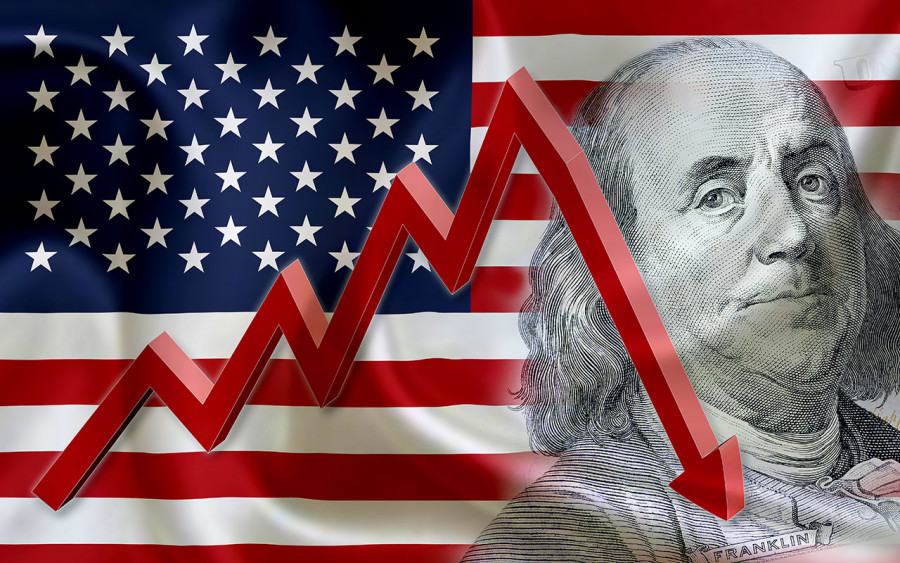
According to the latest report on U.S. GDP for the third quarter, the American economy grew by 4.3%. While this is not the maximum possible figure—since in recent years GDP has shown results of +7% and +5%—it is still a very high value. What accounts for this growth, especially considering that the labor market is "cooling," the unemployment rate is rising, industrial production is declining, and retail sales are stable (not growing)?
Economists report that a significant portion of this growth is due to government spending. Yes, the very spending that Donald Trump promised to reduce as part of a program to lower the national debt. The national debt, which, thanks to the "One Big Beautiful Bill," is expected to increase by $3 trillion over the next 10 years. As the government spends more money, GDP rises, but this increase is not driven by genuine economic growth reflected in consumer demand and its fulfillment. Instead, it is a result of artificial stimulation. Indeed, such growth is still growth, but it explains how the economy can grow even when most of its indicators show disappointing results month after month.

Should we celebrate the 4.3% economic growth? In my opinion, no, and the market rightly reacted little to this report. Alongside it were reports on durable goods orders and industrial production, which painted a very different picture. Orders for automobiles, home appliances, and other expensive goods fell by 2.2% in October, and industrial production decreased by 0.1% in October and increased by only 0.2% in November. Thus, at best, we can speak of stagnation in these indicators.
Given all the above, the American economy could grow by 7% each quarter. However, for market participants, the figure itself—which Trump will later boast about from the podium—is not what matters. What is important to market participants is the real picture of what is happening in the U.S. economy. And here, the situation looks entirely different.
Wave Structure of EUR/USD:
Based on the conducted analysis of EUR/USD, I conclude that the instrument continues to build the bullish segment of the trend. Donald Trump's policies and the Fed's monetary policy remain significant factors in the long-term decline of the American currency. The targets of the current trend segment may stretch up to the 25th figure. The current upward wave pattern is starting to show development, and it is hoped that we are now witnessing the formation of an impulse wave set that is part of the global wave 5. In this case, we should expect growth towards targets around 1.1825 and 1.1926, corresponding to 200.0% and 261.8% on the Fibonacci retracement.
Wave Structure of GBP/USD:
The wave structure of the GBP/USD instrument has changed. The downward corrective structure a-b-c-d-e in C of 4 appears to be complete, as does the entire wave 4. If this is indeed the case, I expect the primary trend segment to resume its development, with initial targets around the 38 and 40 levels.
In the short term, I anticipated the formation of wave 3 or c, with targets around the 1.3280 and 1.3360 marks, corresponding to 76.4% and 61.8% on the Fibonacci retracement. These targets have been reached. Wave 3 or c continues its formation, and currently, a fourth attempt to break the 1.3450 mark (equating to 61.8% on the Fibonacci retracement) is underway. Movement targets are 1.3550 and 1.3720.
Core Principles of My Analysis:
- Wave structures should be simple and understandable. Complex structures are difficult to trade and often require adjustments.
- If there is uncertainty about what is happening in the market, it is better not to enter it.
- There is never 100% certainty in the direction of movement, and there never can be. Don't forget about protective stop-loss orders.
- Wave analysis can be combined with other forms of analysis and trading strategies.
Why Nonfarm Payrolls Cannot Be Fully Trusted?
.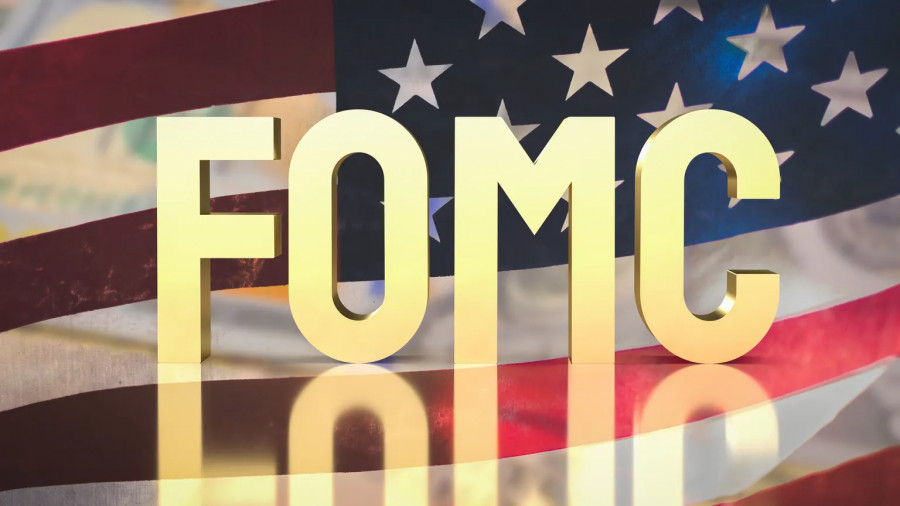
Generally, markets react very sensitively to Nonfarm Payrolls reports and often show indifference to unemployment reports. For example, the data for these two indicators in November did not cause a significant decline in the U.S. dollar. In my opinion, this represents another market oversight suggesting a future decline of the American currency.
Nonfarm Payrolls reports do not always account for all new jobs created. In the 21st century, some professions are extremely difficult to quantify. For instance, any form of freelancing or piecework employment. Nowadays, every second person is a blogger, managing their accounts on YouTube or similar platforms. Many people simply take on various orders on freelance exchanges. How can we count them, and how can we calculate that?
Even Jerome Powell has spoken about the issues with the Nonfarm Payrolls indicator. According to him, the actual labor market data may be lower than the official statistics. Some reports suggest that the American labor market has been losing 20,000 to 30,000 jobs since the spring of 2025. Clearly, these are unofficial statistics, but one must concede that such an assumption has merit.
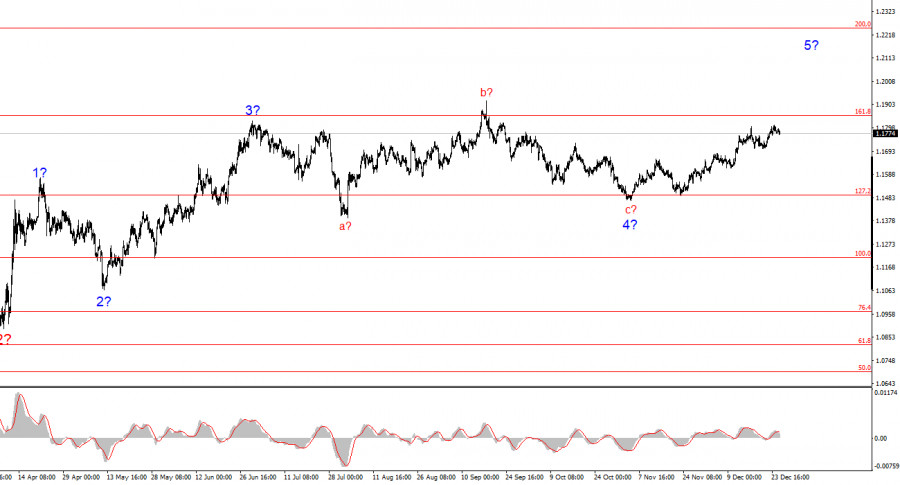
I consider the unemployment rate to be a much more important indicator. If the labor market began to "cool down" only at the end of summer, the unemployment rate has been rising since January 2023. Consequently, problems in the labor market have been emerging for two years. It is obvious that the unemployment rate reflects the labor market situation more accurately because when an individual loses their job and cannot support themselves, they apply for unemployment benefits. As a result, new jobs might be created (according to Nonfarm Payrolls), even up to 600,000, but if 800,000 Americans lost their jobs during the same period, the unemployment rate would still increase. This is why payroll figures are not the most accurate indicator, just as the ADP or JOLTs reports are.
Since unemployment has been rising for 2 years, it is easy to speculate that the labor market is continuing to "cool down." If this assumption is correct, the FOMC's interest rate cuts will continue into 2026. With weak inflation, the cuts will happen sooner; with high inflation, they will occur more slowly. For the U.S. dollar, this is undoubtedly bad news.
Wave Structure of EUR/USD:
Based on the conducted analysis of EUR/USD, I conclude that the instrument continues to build the bullish segment of the trend. Donald Trump's policies and the Fed's monetary policy remain significant factors in the long-term decline of the American currency. The targets of the current trend segment may stretch up to the 25th figure. The current upward wave pattern is starting to show development, and it is hoped that we are now witnessing the formation of an impulse wave set that is part of the global wave 5. In this case, we should expect growth towards targets around 1.1825 and 1.1926, corresponding to 200.0% and 261.8% on the Fibonacci retracement.
Wave Structure of GBP/USD:
The wave structure of the GBP/USD instrument has changed. The downward corrective structure a-b-c-d-e in C of 4 appears to be complete, as does the entire wave 4. If this is indeed the case, I expect the primary trend segment to resume its development, with initial targets around the 38 and 40 levels.
In the short term, I anticipated the formation of wave 3 or c, with targets around the 1.3280 and 1.3360 marks, corresponding to 76.4% and 61.8% on the Fibonacci retracement. These targets have been reached. Wave 3 or c continues its formation, and currently, a fourth attempt to break the 1.3450 mark (equating to 61.8% on the Fibonacci retracement) is underway. Movement targets are 1.3550 and 1.3720.
Core Principles of My Analysis:
- Wave structures should be simple and understandable. Complex structures are difficult to trade and often require adjustments.
- If there is uncertainty about what is happening in the market, it is better not to enter it.
- There is never 100% certainty in the direction of movement, and there never can be. Don't forget about protective stop-loss orders.
- Wave analysis can be combined with other forms of analysis and trading strategies.
Why Does the Dollar Have No Chances in 2026?
.
In this review, we will analyze the movements of the EUR/USD instrument in the fall of 2025. Why do I consider the autumn period important for the prospects of the American currency? Because, in my opinion, the market was dominated by corrective sentiments that did not always align with the news backdrop and wave formations. To be honest, if, after completing another global bullish wave, the EUR/USD instrument had formed a minimal set of corrective waves, nobody would have opposed it, nor would anyone have been surprised. However, instead of the classic "three," we saw a whole series of corrective structures lasting five or six months. The correction was weak but prolonged and exhausting.
Throughout the autumn, the market continued trading horizontally, although there were plenty of reasons to sell the dollar. Let's analyze the situation. Firstly, the "shutdown." Who among my readers can say that a "shutdown" is a positive event for the American economy? Indeed, it is not about a 1% or 2% slowdown in the economy due to this event, but it can hardly be called positive. However, throughout the "shutdown" period, demand for the U.S. currency increased.
Secondly, the Fed eased monetary policy twice in the fall. The anticipated wave "c" in 4 began after the September Fed meeting, and the inner wave "e" in "c" in 4 started after October. In both cases, the instrument declined, indicating increased demand for U.S. currency. Based on this, I believe the "shutdown" and the two rounds of easing were not fully reflected in market prices. In mid-December, the FOMC conducted the third consecutive round of easing, after which demand for the U.S. currency began to decline.
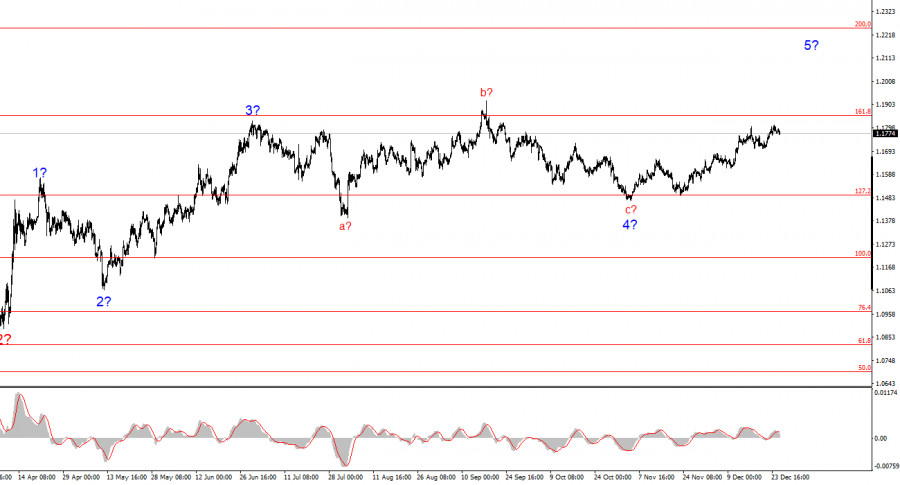
Given that the prospects for the U.S. labor market recovery are rather bleak and inflation slowed to 2.7% year-over-year in November, I do not rule out a fourth round of easing in January. Certainly, Jerome Powell and some of his colleagues have discussed the need to pause in recent weeks, but we have yet to see the December data on unemployment, payrolls, and inflation. What if the labor market cools again, the unemployment rate rises, and inflation decreases?
Wave Structure of EUR/USD:
Based on the conducted analysis of EUR/USD, I conclude that the instrument continues to build the bullish segment of the trend. Donald Trump's policies and the Fed's monetary policy remain significant factors in the long-term decline of the American currency. The targets of the current trend segment may stretch up to the 25th figure. The current upward wave pattern is starting to show development, and it is hoped that we are now witnessing the formation of an impulse wave set that is part of the global wave 5. In this case, we should expect growth towards targets around 1.1825 and 1.1926, corresponding to 200.0% and 261.8% on the Fibonacci retracement.
Wave Structure of GBP/USD:
The wave structure of the GBP/USD instrument has changed. The downward corrective structure a-b-c-d-e in C of 4 appears to be complete, as does the entire wave 4. If this is indeed the case, I expect the primary trend segment to resume its development, with initial targets around the 38 and 40 levels.
In the short term, I anticipated the formation of wave 3 or c, with targets around the 1.3280 and 1.3360 marks, corresponding to 76.4% and 61.8% on the Fibonacci retracement. These targets have been reached. Wave 3 or c continues its formation, and currently, a fourth attempt to break the 1.3450 mark (equating to 61.8% on the Fibonacci retracement) is underway. Movement targets are 1.3550 and 1.3720.
Core Principles of My Analysis:
- Wave structures should be simple and understandable. Complex structures are difficult to trade and often require adjustments.
- If there is uncertainty about what is happening in the market, it is better not to enter it.
- There is never 100% certainty in the direction of movement, and there never can be. Don't forget about protective stop-loss orders.
- Wave analysis can be combined with other forms of analysis and trading strategies.
EUR/USD Analysis on December 26, 2025
.The wave pattern on the 4-hour chart of EUR/USD looks fairly clear, albeit somewhat complex. There is no talk of canceling the upward segment of the trend that began in January 2025, but the wave structure since July 1 has taken on a complex and extended form. In my view, the instrument has completed the formation of corrective wave 4, which took on a very non-standard shape. Within this wave, we observed exclusively corrective structures, so there is no doubt about the corrective nature of the decline.
In my opinion, the construction of the upward segment of the trend is not finished, and its targets may extend all the way up to the 1.25 level. The series of waves a–b–c–d–e appears complete; therefore, in the coming weeks I expect a new upward wave sequence to form. We have seen the presumed waves 1 and 2, and the instrument is now in the process of forming wave 3, or c. I had expected that within this wave the instrument would rise to the level of 1.1717, which corresponds to the 38.2% Fibonacci retracement. However, this wave is taking on a more extended form, which is very positive, as in this case it may turn out to be impulsive—and along with it, the entire upward wave sequence.
The EUR/USD rate barely changed on Friday, with the total price range amounting to just 15 basis points by the opening of the U.S. session. Overall, I do not expect to see or hear anything interesting this week. Let me remind you that the only events this week were three U.S. reports, which left a contradictory aftertaste—much like the entire news backdrop in December.
While GDP volumes grew by as much as 4.3% quarter-on-quarter in the third quarter (second estimate), industrial production once again lost momentum, and orders for durable goods declined. Let me also remind you that earlier, pivotal reports on inflation, unemployment, and the labor market were released, which are also difficult to count as positives for the dollar. Although payrolls in November came in slightly above market expectations, the October payroll figure set an anti-record for the past several years. The unemployment rate rose, while inflation declined. The latter could have been considered a positive factor for the U.S. currency if not for one "small" caveat—declining inflation sharply increases market dovish expectations for 2026. In other words, the faster inflation falls amid a weak labor market, the more rounds of rate cuts the Fed will carry out next year. There is no need to look at current analyst forecasts or the CME FedWatch tool—everything will depend solely on incoming economic data.
Overall Conclusions
Based on the EUR/USD analysis conducted, I conclude that the instrument continues to build an upward segment of the trend. Donald Trump's policies and the Federal Reserve's monetary policy remain significant factors weighing on the U.S. dollar in the long term. The targets of the current trend segment may extend all the way to the 1.25 level. The current upward wave sequence is beginning to gain momentum, and one would like to believe that we are now observing the formation of an impulsive wave sequence as part of the global wave 5. In this case, growth should be expected with targets near 1.1825 and 1.1926, corresponding to the 200.0% and 261.8% Fibonacci levels.
On a smaller scale, the entire upward trend segment is clearly visible. The wave labeling is not the most standard, as corrective waves differ in size. For example, the larger wave 2 is smaller than the internal wave 2 within wave 3. However, this does happen. Let me remind you that it is best to identify clear and understandable structures on charts, rather than rigidly tying analysis to every single wave. At present, the bullish structure raises no doubts.
Core Principles of My Analysis
- Wave structures should be simple and clear. Complex structures are difficult to trade and often signal changes.
- If there is no confidence in what is happening in the market, it is better to stay out.There is no and can never be 100% certainty about the direction of price movement. Do not forget to use protective Stop Loss orders.
- Wave analysis can be combined with other types of analysis and trading strategies.
Trading Signals for Etehreum for December 26-29, 2025: sell below $2,980 (21 SMA - rebound)
.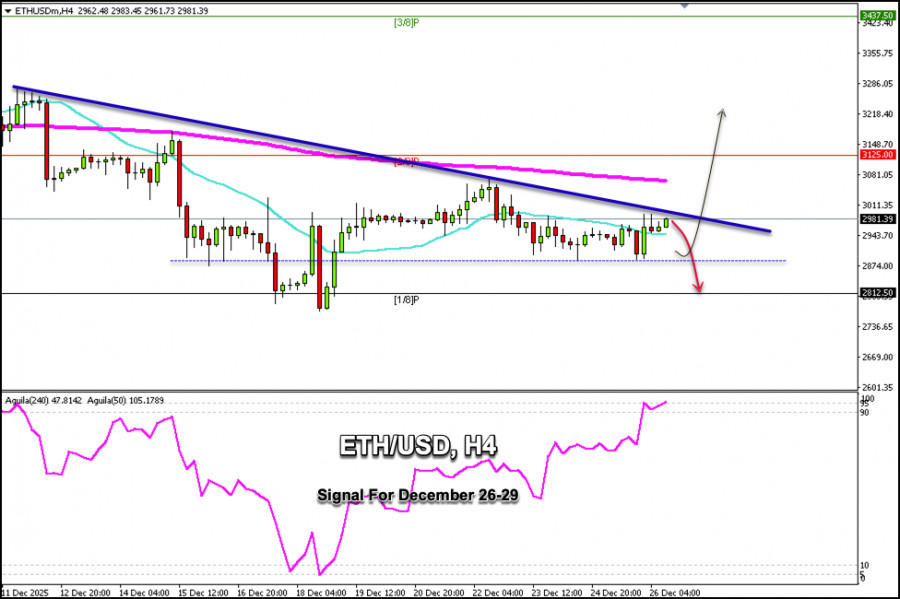
Ethereum is trading around $2,981, exhibiting signs of exhaustion and approaching resistance levels, as evident on the H4 chart.
ETH/USD is testing the top of the downtrend channel formed on December 10. If the cryptocurrency manages to break above this level, we could expect an upward acceleration, and it could reach $3,125 or even the 3/8 Murray at $3,437.
The H4 chart shows that the Eagle indicator has reached overbought levels, and a technical correction is more likely to occur in the coming hours towards the key support level of $2,880.
If Ether finds good support around $2,880, it could be seen as an opportunity to open long positions on the technical rebound.
In case of a sharp break below the key support level of $2,880, a bearish acceleration could occur, and ETH could reach the 1/8 Murray around 2,812.
Our outlook remains bearish for the coming hours as long as the price trades below the downtrend channel formed since December 10.
The material has been provided by InstaForex Company - www.instaforex.com.Trading Signals for EUR/USD for December 26-29, 2025: sell below 1.1803 (21 SMA - 5/8 Murray)
.
EUR/USD is trading around 1.1792, reaching the strong resistance zone around 1.1803 with an upward bias after covering the gap left during the holidays.
The euro has strong resistance around 1.1800. This area could serve as a key point for resuming the bearish sequence, and we could expect EUR/USD to reach 4/8 Murray at 1.1718 in the short term.
If the euro manages to remain below the resistance level of 1.1803 in the coming hours, it will be seen as an opportunity to open short positions with targets at 1.1764, 1.1718, and finally at the 200 EMA around 1.1672.
Our outlook remains bearish as we observe a triple top pattern forming, which could confirm the decline of the EUR/USD pair in the coming days. The Eagle indicators are showing a negative signal.
The material has been provided by InstaForex Company - www.instaforex.com.Trading Signals for BITCOIN for December 26-29, 2025: sell below $89, 500 (21 SMA - 2/8 Murray)
.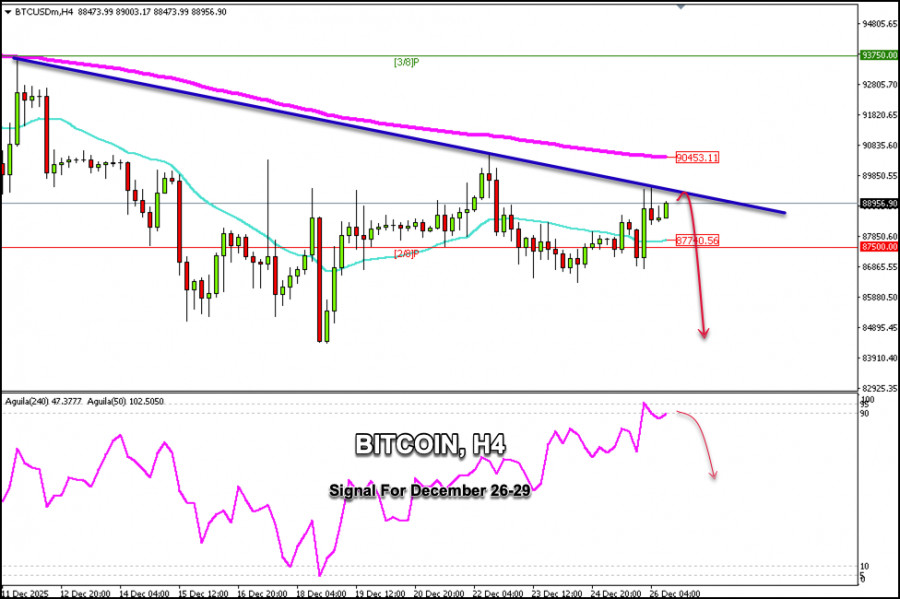
Bitcoin is rising above the 2/8 Murray after a brief pause around $87,500. BTC has gained bullish momentum above this area.
If the bullish force prevails, it could be seen as a signal to open long positions. We believe that it could reach the 200 EMA around $90,453 in the coming days and even reach $93,750.
There is a negative divergence, which should make us very cautious, as the Eagle indicator is reaching overbought levels. So, it is likely that after a strong upward movement or around $89,000-$90,500, we could expect a new technical correction.
Bitcoin is likely to undergo a technical correction from current price levels, as we observe that it is reaching the top of the downtrend channel, which could act as a strong barrier.
On the other hand, if BTC breaks through this resistance zone, it could face the next resistance around $90,453 (200 EMA). The Eagle indicator is showing exhaustion of bullish strength, and it is likely that there could be a technical correction in the coming hours.
The outlook could be bearish for the next few hours as long as the price trades below $89,500. If Bitcoin finds good support around the 2/8 Murray, it will be seen as an opportunity to open long positions on the technical rebound.
The material has been provided by InstaForex Company - www.instaforex.com.USD/JPY. An Important Signal for the Yen: What Does the Tokyo CPI Growth Report Tell Us?
.The current week is a series of holidays or semi-holidays: Christmas Eve, Christmas Day, Boxing Day, and St. Stephen's Day. The FX market continues to trade amid low liquidity, especially in the second half of the week, when an information vacuum has formed. In this respect, Japan is virtually the only source of news, playing a kind of role as a news provider and exerting a corresponding influence on the yen.
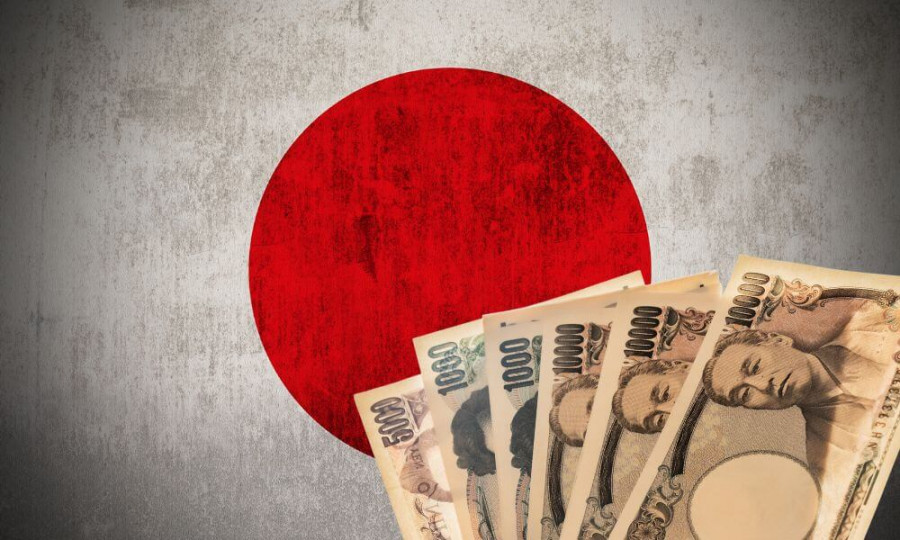
During Friday's Asian trading session, Japan published data on inflation growth in Tokyo for December of this year. It became known that the consumer price index in the Japanese capital slowed sharply this month—to 2.0%, after declining to 2.7% in November. The indicator has been falling for the second month in a row and hit a yearly low in December. The index was below the 2% level in October 2024. Core Tokyo CPI, excluding fresh food prices, also came out in the red, declining to 2.3% versus a forecast of a slowdown to 2.5% (from the previous 2.8%). This is a multi-month low—the lowest reading since February of this year. Tokyo CPI excluding fresh food and fuel prices also showed a slowdown in December—to 2.6% (2.8% in November).
As is well known, Tokyo inflation is considered a "harbinger" of nationwide inflation in Japan. First, the Tokyo CPI is released about 3–4 weeks earlier than the nationwide CPI. Second, the indicator is highly representative, as Tokyo is the country's largest metropolitan area with a high share of consumption in services, rent, transport, and food (categories that often reflect changes in price pressures first). Third, there is historical correlation: in most cases, the direction of Tokyo CPI (acceleration or deceleration) later matches what happens at the national level. Therefore, the Bank of Japan and analysts use this indicator when forming expectations for interest rates and inflation.
Of course, TCPI is not a "perfect predictor with pinpoint accuracy." Regional differences must be taken into account—municipal subsidies, housing rents, and utility tariffs can differ from those in Tokyo (sometimes quite significantly). For example, temporary electricity/gas subsidies sometimes have a stronger impact on the capital than on other prefectures.
Nevertheless, Tokyo CPI predicts the direction of the "senior" indicator fairly accurately: if inflation in Japan's capital slows or accelerates, there is a high probability that nationwide inflation will follow suit. That is why USD/JPY traders quite reasonably interpreted today's report as unfavorable for the yen.
What does the release indicate? First of all, that inflation in Tokyo cooled more than economists expected, reflecting an overall easing of price pressures in the economy. The structure of the report suggests that the decline in TCPI was driven mainly by falling energy prices and more moderate growth in food and utility prices.
On the one hand, despite the downward dynamics of key TCPI indicators, core inflation remains above the Bank of Japan's 2% target. Theoretically, this leaves room for continued monetary tightening. On the other hand, the pace of the decline in Tokyo inflation turned out to be much stronger than expected, and this fact cannot be ignored.
It is worth recalling that following its December meeting, the Bank of Japan raised the policy rate to 0.75% (the highest level in the past 30 years) and signaled readiness for further steps in this direction "if wage growth and economic conditions support it."
At the same time, today's TCPI report strengthens the case for a wait-and-see stance by the Bank of Japan, at least in the context of the January and March meetings. At the same time, the release does not completely close the door to monetary tightening. Now the focus of both the central bank and the market will naturally shift to wages. In fact, wages are currently the main "missing element" in the BoJ's argumentation.
By and large, TCPI has eased the pressure on the Bank of Japan, freeing it from the need to act or react "right here and now." At the same time, the report has increased the importance of wage data as the next decisive factor.
It should be noted that winter wage statistics will be viewed by the Bank of Japan as auxiliary and subject to seasonal distortions. The key factor for assessing the sustainability of inflation (and the central bank's next steps) will be the spring wage negotiations (Shunto). Until then, the central bank is likely to maintain a wait-and-see stance.
Thus, Tokyo inflation turned out to be unfavorable for the yen, allowing USD/JPY buyers to stage a corrective rebound after a three-day prolonged decline (caused by the general weakening of the U.S. dollar). However, considering long positions in the pair makes sense only if it breaks above the resistance level at 156.70 (the Kijun-sen line on the four-hour chart). In that case, the pair will not only be above all Bollinger Bands lines on the H4 timeframe, but also above all Ichimoku lines, which would form a bullish "Parade of Lines" signal. The upward targets are 157.10 and 157.40 (the upper Bollinger Bands on the H4 and D1 timeframes, respectively).
The material has been provided by InstaForex Company - www.instaforex.com.EUR/JPY. Analysis and Forecast
.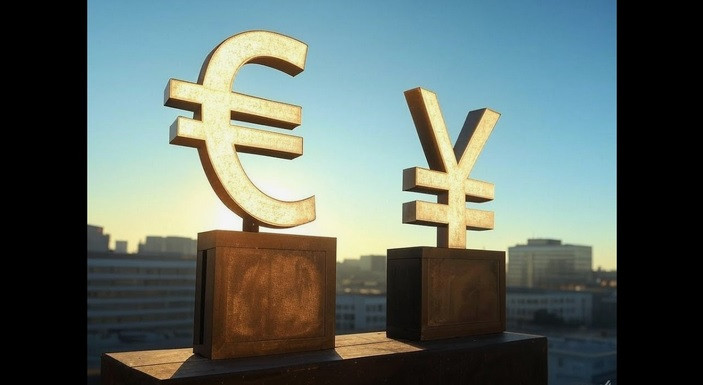
Today, the pair interrupted a two-day decline and is moving higher, heading toward the December high. At the same time, the 14-day Relative Strength Index (RSI) has exited the overbought zone, supporting a positive bias for EUR/JPY.
Prices are holding above the 9-day Exponential Moving Average (EMA), with the 9-day EMA positioned above the 14-day EMA, confirming a positive outlook for the pair. Both moving averages are rising, reinforcing the bullish structure.
The EUR/JPY pair may rebound toward the all-time high of 184.95, recorded on December 22, coming close to the round 185.00 level.
Immediate support is located at the 9-day EMA around 183.35, followed by the round 183.00 level. A break below this level would find support at the 20-day Simple Moving Average (SMA), with the next stop near 182.20. Failure to hold this level could accelerate the decline toward 181.50, on the way to the next round level at 181.00, below which lies the 50-day SMA.
The material has been provided by InstaForex Company - www.instaforex.com.EUR/USD. Smart Money. The Market Has Opened, but Traders Are Still Celebrating
.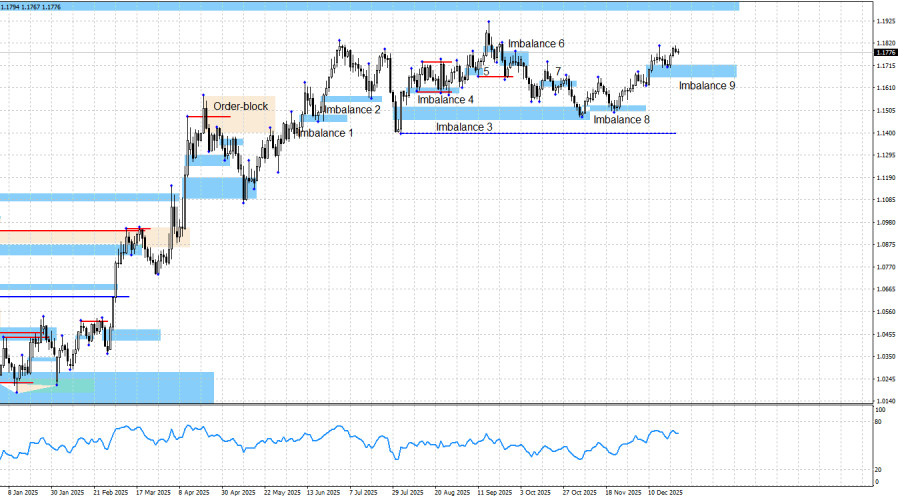
The EUR/USD pair rebounded from the bullish imbalance 9 zone, which gave us another buy signal. Let me remind you that it all started earlier with bullish imbalances 3 and 8. The pair formed two buy signals, and traders had an excellent opportunity to enter in continuation of the bullish trend at the most favorable price. This long position is now showing a profit of about 260 points. Traders can decide for themselves what to do next: wait for a larger profit or close the position now. Personally, I am expecting further growth from the euro. Over recent months, I have repeatedly drawn traders' attention to an obvious fact: the bullish trend remains intact. Thus, all this time I have been waiting for a new bullish offensive. Now I am waiting for the 2025 highs to be tested and for the weekly bearish imbalance (visible on the chart) to be worked off. Over the past three days, market movement has been virtually nonexistent, which is easily explained by the Christmas and New Year holidays. Most likely, meaningful movement should be expected only in the new year.
The chart picture continues to signal bullish dominance. The bullish trend remains in place: a reaction to bullish imbalance 3 has been received, a reaction to bullish imbalance 8 has been received, and a reaction to bullish imbalance 9 has been received. Despite the fairly prolonged decline of the European currency, the dollar has failed to break the bullish trend. It had five months to do so and achieved no result. If bearish patterns or signs of a breakdown of the bullish trend appear, the strategy can be adjusted. However, at the moment, nothing indicates this.
There was no news background on Friday, and trader activity ahead of the New Year and immediately after Christmas was minimal. Despite fairly active trading on Monday and Tuesday, volatility nevertheless fell almost to zero. Today, the market is closed until Monday.
The bulls have had plenty of reasons for a new offensive for three months now, and all of them remain relevant. These include the (in any case) dovish outlook for FOMC monetary policy, Donald Trump's overall policy (which has not changed recently), the U.S.–China confrontation (where only a temporary truce has been reached), protests against Trump (which have swept across the U.S. three times already this year), weakness in the labor market, bleak prospects for the U.S. economy (recession), and the shutdown (which lasted a month and a half but was clearly not fully priced in by traders). Thus, in my view, further growth of the pair will be entirely logical.
One should also not lose sight of Trump's trade war and his pressure on the FOMC. Recently, new tariffs have been introduced rarely, and Trump himself has stopped criticizing the Fed. But personally, I believe this is just another "temporary lull." In recent months, the FOMC has been easing monetary policy, which is why no new wave of criticism from Trump has emerged. However, this does not mean that these factors no longer create problems for the dollar.
I still do not believe in a bearish trend. The news background remains extremely difficult to interpret in favor of the dollar, which is why I do not even try to do so. The blue line shows the price level below which the bullish trend could be considered completed. Bears would need to push the price down by about 400 points to reach it, and I consider this task impossible under the current news background and present circumstances. The nearest growth target for the euro remains the bearish imbalance zone of 1.1976–1.2092 on the weekly chart, which was formed back in June 2021.
News calendar for the U.S. and the Eurozone:
On December 29, the economic calendar contains no noteworthy events. The impact of the news background on market sentiment on Monday will be absent.
EUR/USD forecast and trader advice:
In my view, the pair may be in the final stage of the bullish trend. Despite the fact that the news background remains on the side of the bulls, bears have attacked more often in recent months. Still, I currently see no realistic reasons for the start of a bearish trend.
From imbalances 1, 2, 4, and 5, traders had opportunities to buy the euro. In all cases, we saw some degree of growth. Opportunities to open new trend-following long positions appeared when a reaction to bullish imbalance 3 was received, then after a reaction to imbalance 8, and this week—after the rebound from imbalance 9. The growth target for the euro remains 1.1976. Buy positions can be kept open, with stop-loss orders moved to breakeven.
The material has been provided by InstaForex Company - www.instaforex.com.GBP/USD. Smart Money. Waiting for a New "Bullish" Signal
.
The GBP/USD pair rebounded from the "bullish" imbalance 11 and resumed its growth, just as I had expected. The reaction to bullish imbalance 11 was twofold: the first buy signal was generated back last week. At this point, long positions are already showing a profit of about 400 pips by the most conservative estimates, and traders can decide for themselves how to manage them going forward. The market was closed on Thursday and reopened on Friday, but activity is virtually nonexistent. There is no news background, and the desire to trade on a day "detached" from the others is unlikely to arise for traders on the last day of the week. Nevertheless, I expect the growth of the pound to continue further. I would note that this week a new bullish imbalance 12 was formed, which may in the future serve as a reason to open new buy positions for those traders who did not do so earlier. And if the pound reacts to this pattern, it will already be the fourth bullish signal in a row.
The current chart picture is as follows. The bullish trend in the pound can be considered completed, but the bullish trend in the euro has not. Thus, the European currency may pull the pound upward, although the pound itself has been growing quite well in recent weeks. Bulls bounced from bullish imbalance 1, from bullish imbalance 10, and twice from bullish imbalance 11. A large number of buy signals have been formed. There are no bearish patterns above the current price for the pound—there is nothing to stop the rise. At the same time, a new support zone has formed below—imbalance 12. Therefore, I assume growth toward the yearly highs, around the 1.3765 level.
There was no news background on Friday. However, new graphical buy signals may emerge before the end of the year, and the rally itself may continue next week. For many Europeans and Americans, New Year's as a holiday is of lower priority than Christmas.
In the U.S., the overall news background remains such that nothing but a decline in the dollar can be expected in the long term. The situation in the United States remains quite difficult. The shutdown lasted a month and a half, and Democrats and Republicans have only agreed on funding through the end of January. There has been no U.S. labor market data for a month and a half, and the latest figures can hardly be considered positive for the dollar. The last three FOMC meetings ended with "dovish" decisions, and the most recent labor market data allow for a fourth consecutive easing of monetary policy in January. In my view, the bulls have everything they need to continue a new offensive and return to the yearly highs.
For a bearish trend, a strong and stable positive news background for the U.S. dollar is needed, which is difficult to expect under Donald Trump. Moreover, the U.S. president himself does not need a strong dollar, as in that case the trade balance would remain in deficit. Therefore, I still do not believe in a bearish trend for the pound, despite the rather strong decline that lasted two months. Too many risk factors continue to weigh heavily on the dollar. The current bullish trend can be considered completed, as prices fell below two lows (from May 12 and August 1), but what will drive the bears to push the pound further down? Precisely because I cannot answer this question, I do not believe that the process of dollar decline will continue. If new bearish patterns appear, a potential decline in the pound can be reconsidered.
News calendar for the U.S. and the UK:
On December 29, the economic calendar contains no noteworthy events. The impact of the news background on market sentiment on Monday will be absent.
GBP/USD forecast and trader advice:
For the pound, the picture is beginning to look more pleasant. Three bullish patterns have been worked out, signals have been formed, and traders can maintain buy positions. I see no informational grounds for a bearish trend in the near future.
A resumption of the bullish trend could have been expected already from the imbalance 1 zone. At this point, the pound has reacted to imbalance 1, imbalance 10, and imbalance 11. As a potential growth target, I am considering the 1.3725 level, although the pound may rise much higher—albeit next year. If bearish patterns form, the trading strategy may need to be reconsidered, but for now I see no reason to do so.
The material has been provided by InstaForex Company - www.instaforex.com.Bitcoin stuck in deadlock
.Bitcoin is ending 2025 in a deadlock. The cryptocurrency shows few signs of life, remaining in consolidation within the range of 84,000 to 94,000. An asset that has grown over the years due to hype, volatility, and quick fluctuations now lies in the shadow of American stock indices returning to record levels, while gold is ready to showcase its best performance since 1979. Apart from the price, this year has been quite notable for the digital asset.
Dynamics of Bitcoin and other assets in 2025
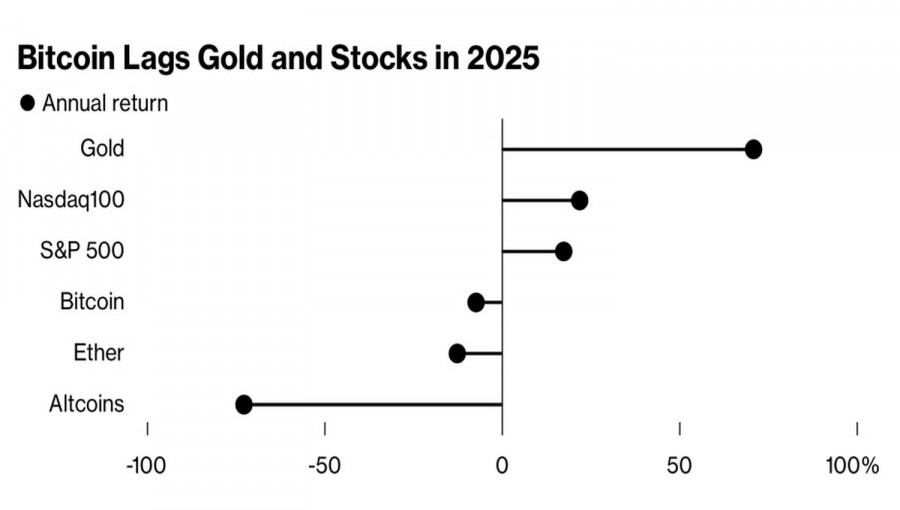
In 2025, the volume of cryptocurrency transactions quadrupled—from $2.17 billion to $8.6 billion. Major transactions included Coinbase's acquisition of the derivatives trading platform Deribit for $2.9 billion, Kraken's purchase of the American futures retail platform NinjaTrader for $1.5 billion, and Ripple's acquisition of the cryptocurrency prime broker Hidden Road for $1.25 billion.
The total number of transactions increased to 267, an 18% rise. While this may not seem as impressive as the volume itself, it's still a solid figure. When considering the widespread desire among companies engaged in digital assets to go public, a more friendly regulatory environment, the rollback of lawsuits against crypto companies, and the lifting of bans, 2025 can confidently be called a successful year for Bitcoin—aside from the price.
Dynamics of BTC/USD and the moving average

The arrival of institutional investors in the market led to reduced volatility. BTC/USD stopped being purchased simply because the asset was rising. Some refer to this period as one of maturity, as fears about the cryptocurrency disappearing from financial markets seemed to wane. However, the more significant factor was the surplus.
Crypto whales and long-term holders actively divested their Bitcoin. This represents the fastest token sell-off in at least five years. Supply surged while demand failed to absorb it. Previously popular specialized exchange-traded funds faced capital outflows.
Crypto treasury managers were hesitant to buy digital assets in a bear market. Even industry pioneer Michael Saylor's Strategy began forming reserves after two weeks of acquiring Bitcoin. To do this, the company raised $748 million through the issuance of common stock.

As a result of the cryptocurrency market transitioning to a surplus, the paths of BTC/USD and US stock indices diverged. Bitcoin, once associated with digital gold, hopelessly lagged behind traditional gold. It no longer qualifies as either a risky asset or a safe haven. In other words, it has become irrelevant. It is no surprise that Bitcoin concludes 2025 in a deadlock.
Technical analysis
Technically, the daily chart of BTC/USD continues to show consolidation within the range of 84,000 to 94,000. What is this? Accumulation of longs or distribution of shorts? The answer to this question may only come with Bitcoin's exit from this trading corridor. It may make sense to set sell orders at 84,000 and buy orders at 94,000.
The material has been provided by InstaForex Company - www.instaforex.com.Dollar closes year with dismal dynamic
.Seldom has any US president intervened in the Forex market as much as Donald Trump. Since his election victory in November 2024, Trump trading thrived as the US dollar strengthened. At that time, it was believed that the divergence in economic growth between the United States and other regions would widen due to tariffs. Then came TACO, or "Trump Always Comes Out." Investors realized that the tariffs imposed on Independence Day were a ceiling and would eventually need to be reduced. As a result, the USD index plunged into a wave of sell-offs.
Dynamics of the US dollar since the presidential elections
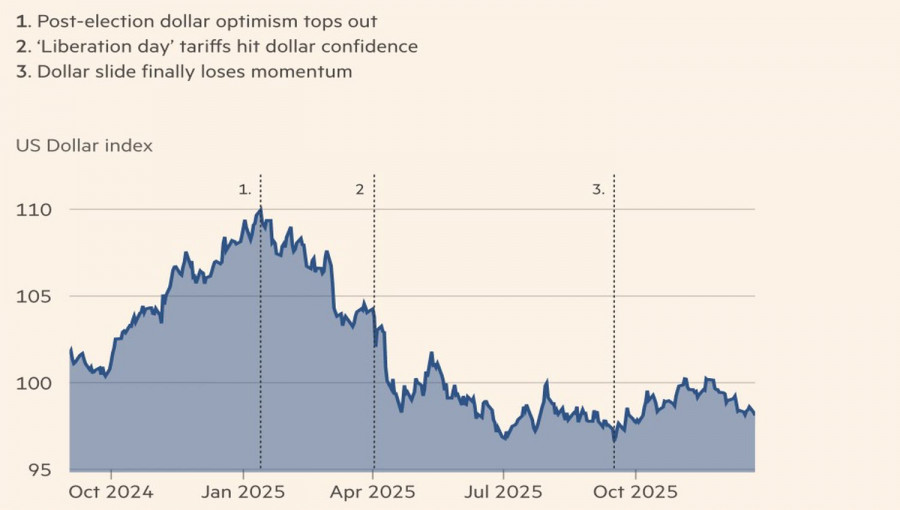
By initiating a restructuring of the international trade system, Donald Trump turned the fundamental principles of Forex rate formation upside down. As a result, after the Federal Reserve cut the federal funds rate in September and October, the US dollar unexpectedly surged. The yen, on the other hand, weakened after the Bank of Japan raised its overnight rate to its highest level since 1995 in December. The markets were faced with numerous paradoxes and mistakes. But, as is known, mistakes are learning opportunities.
Forex traders recalled fiscal dominance—when a president or government pressures the central bank to lower rates or keep them low to reduce debt servicing costs. In the US, this was done by Donald Trump, while in Japan, it was new Prime Minister Sanae Takaichi. The result was the underdog position of the US dollar and yen among G10 currencies in 2025. Markets penalize for undermining trust. However, while Washington may welcome devaluation, Tokyo is not thrilled by it.
The euro faced plenty of challenges this past year, particularly with French politics. However, while the decline of the US dollar was driven by disappointment, the success of the regional currency was a result of underestimation. Let's remember that in 2025, it entered as an underdog. US tariffs were expected to lead to a slowdown in international trade, which would be disastrous for the export-oriented eurozone and its currency.
Expert Predictions for ECB Deposit Rates
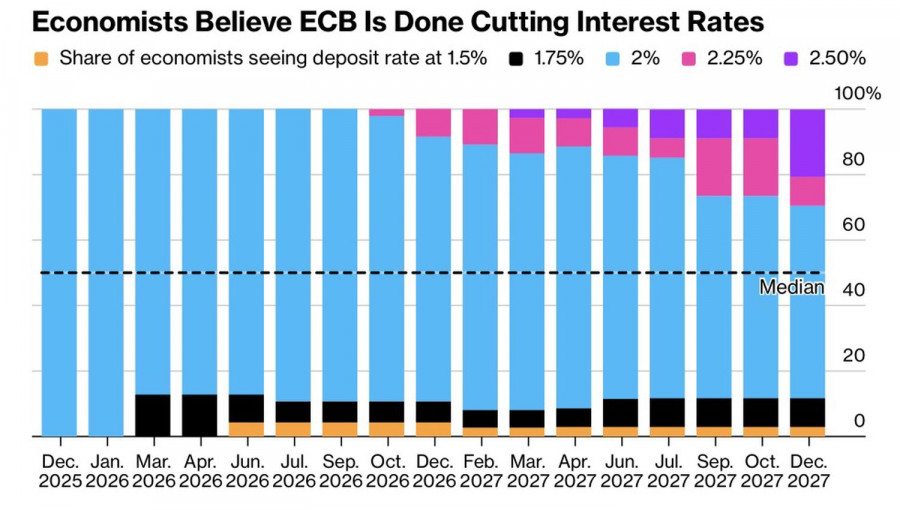
In reality, the currency bloc proved much more resilient to US import tariffs, and the ECB managed to tame inflation. Most Bloomberg experts believe that the ECB has ended its cycle of monetary easing, while the Federal Reserve has not. If that's the case, EUR/USD should continue to rise.

By the end of 2025, everything turned upside down. The euro enters 2026 as a favorite, while the US dollar is now the underdog. Most analysts agree on this outlook. When the market is so heavily saturated with "bulls" in EUR/USD, any positive news from the US or negative news from the eurozone can lead to a sell-off of the main currency pair.
Technically, a Double Top pattern was formed on the daily chart of EUR/USD. A return of the euro to its highs of $1.181 will trigger buy signals. Conversely, a successful breach of support at $1.176 will provide grounds for sales.
The material has been provided by InstaForex Company - www.instaforex.com.Test your Forex Trading Knowledge | Forex Quiz Free Online 2025

Think you know something about forex? So, to help you measure just how great your Forex skills are, we have designed a little quiz to test your knowledge. Test your knowledge and skills with our forex trading free online quiz!
Our Forex Quiz contains 10 randomly selected multiple choice questions from a pool containing hundreds of Forex trading and stock market-related topics related questions. Our Forex quiz is absolutely free to use, it’s ad-free and you can use it as often as you like.
Daily Forex and Economic News • Read RSS News Online
Encyclopedia: Forex market analysis
What is fundamental, graphical, technical and wave analysis of the Forex market?
Fundamental analysis of the Forex market is a method of forecasting the exchange value of a company's shares, based on the analysis of financial and production indicators of its activities, as well as economic indicators and development factors of countries in order to predict exchange rates.
Graphical analysis of the Forex market is the interpretation of information on the chart in the form of graphic formations and the identification of repeating patterns in them in order to make a profit using graphical models.
Technical analysis of the Forex market is a forecast of the price of an asset based on its past behavior using technical methods: charts, graphical models, indicators, and others.
Wave analysis of the Forex market is a section of technical analysis that reflects the main principle of market behavior: the price does not move in a straight line, but in waves, that is, first there is a price impulse and then the opposite movement (correction).
Share with friends:
* Frequently asked questions:
What are the risks of Forex trading?
Trading Forex and Leveraged Financial Instruments involves significant risk. As a result of various financial fluctuations (change liquidity, price or high volatility), you may not only significantly increase your capital, but also lose it completely. You should not invest more than you can afford to lose and should ensure that you fully understand the risks involved.



